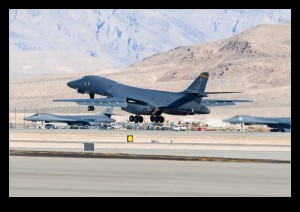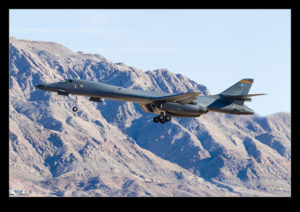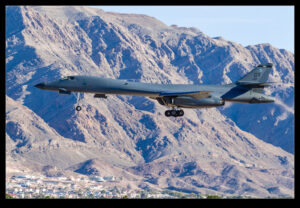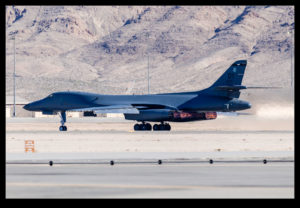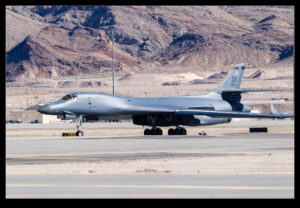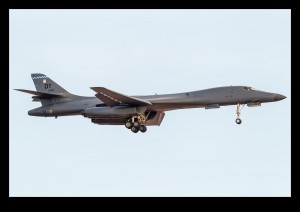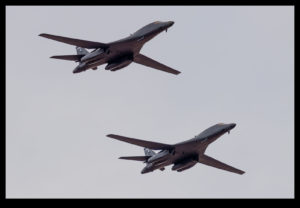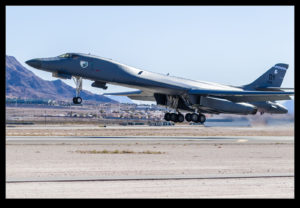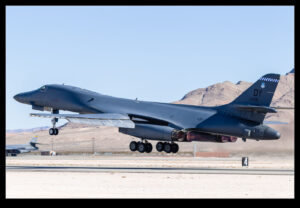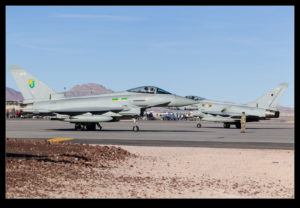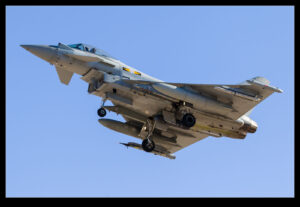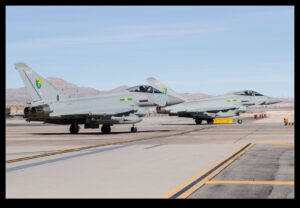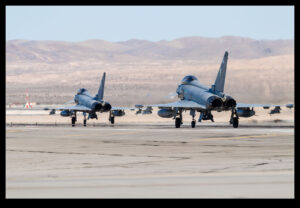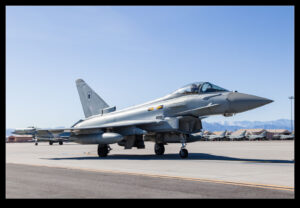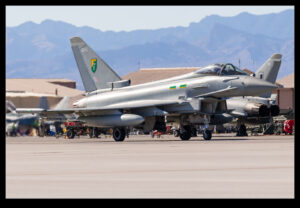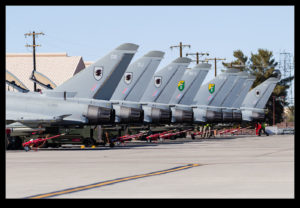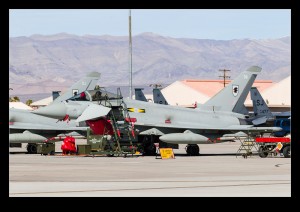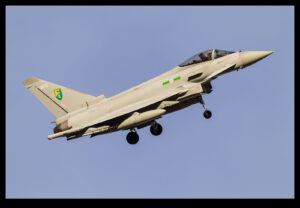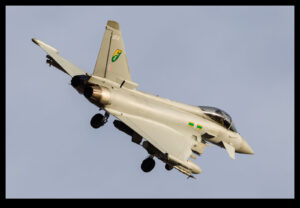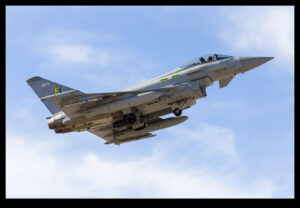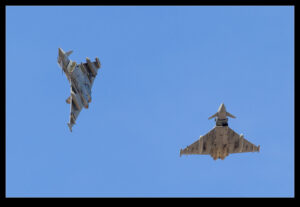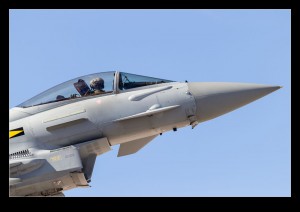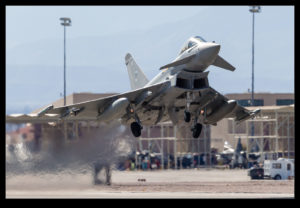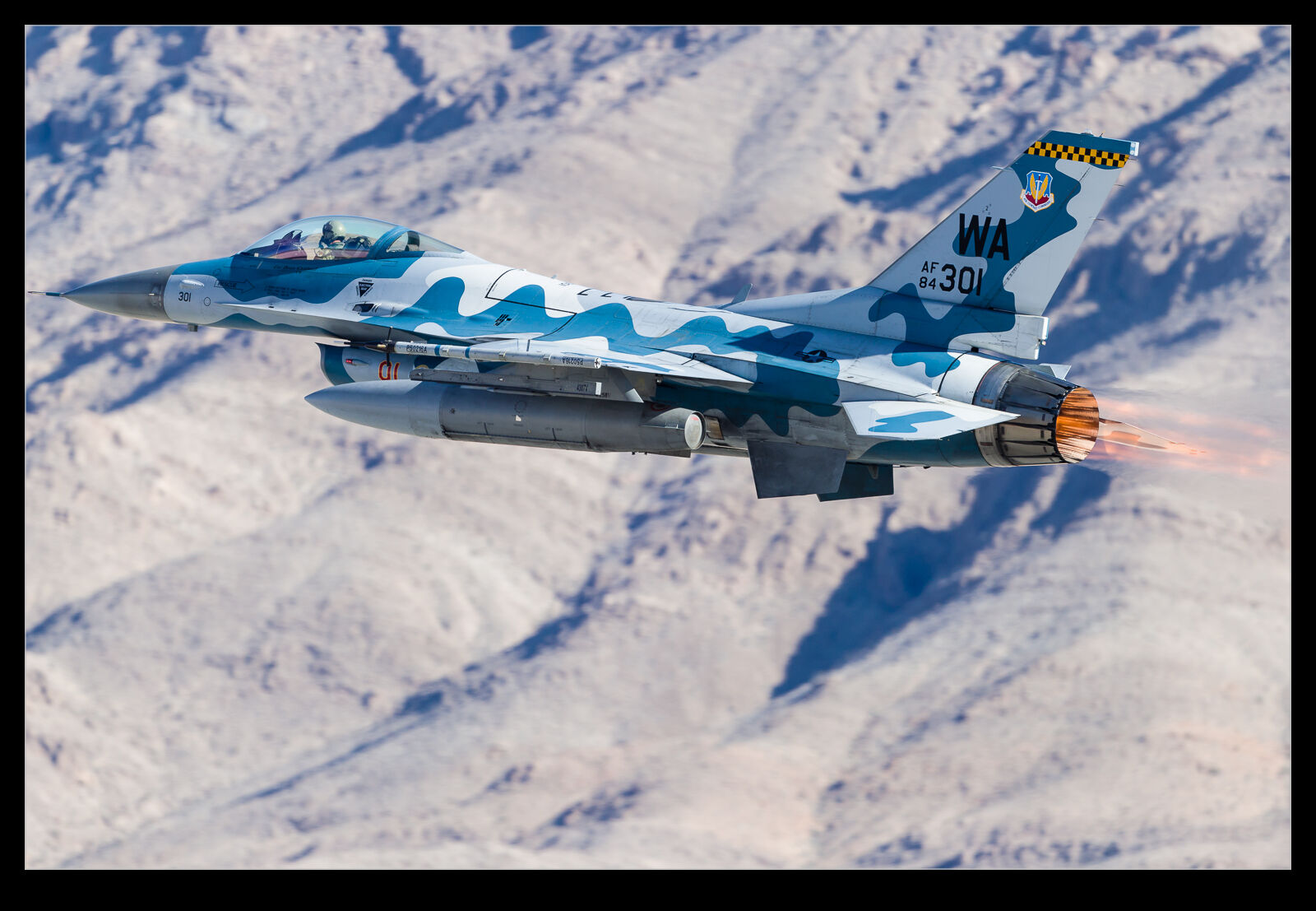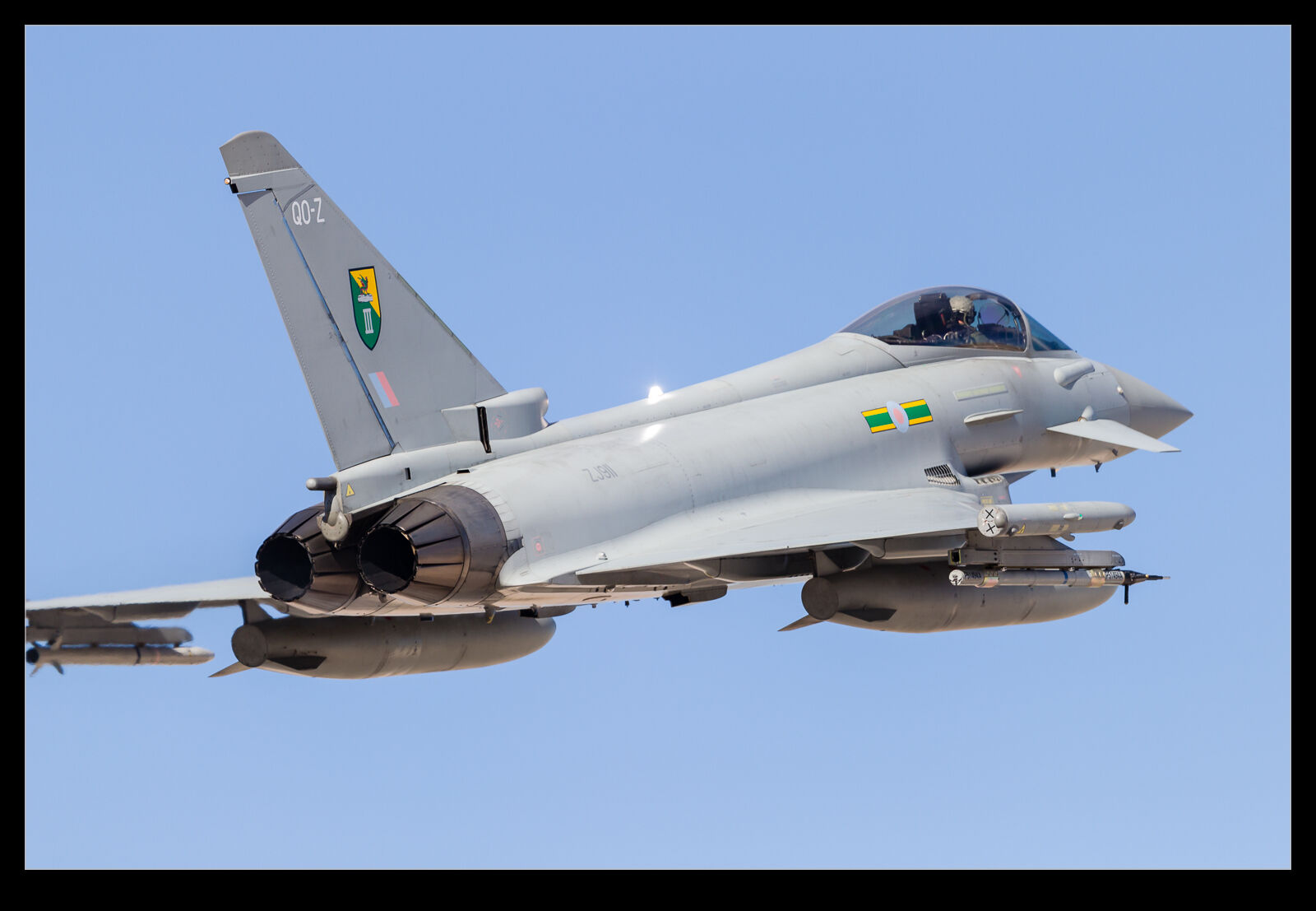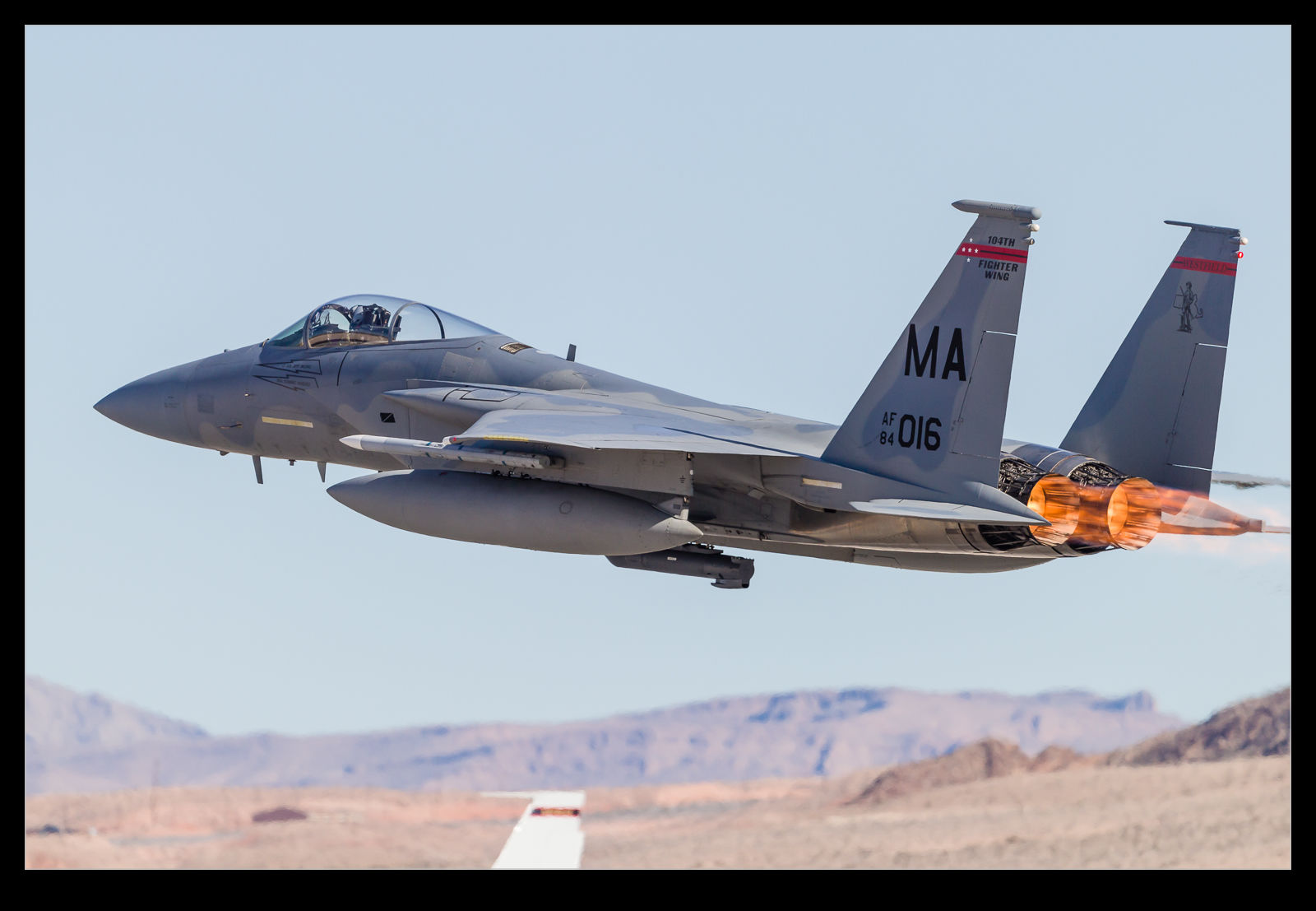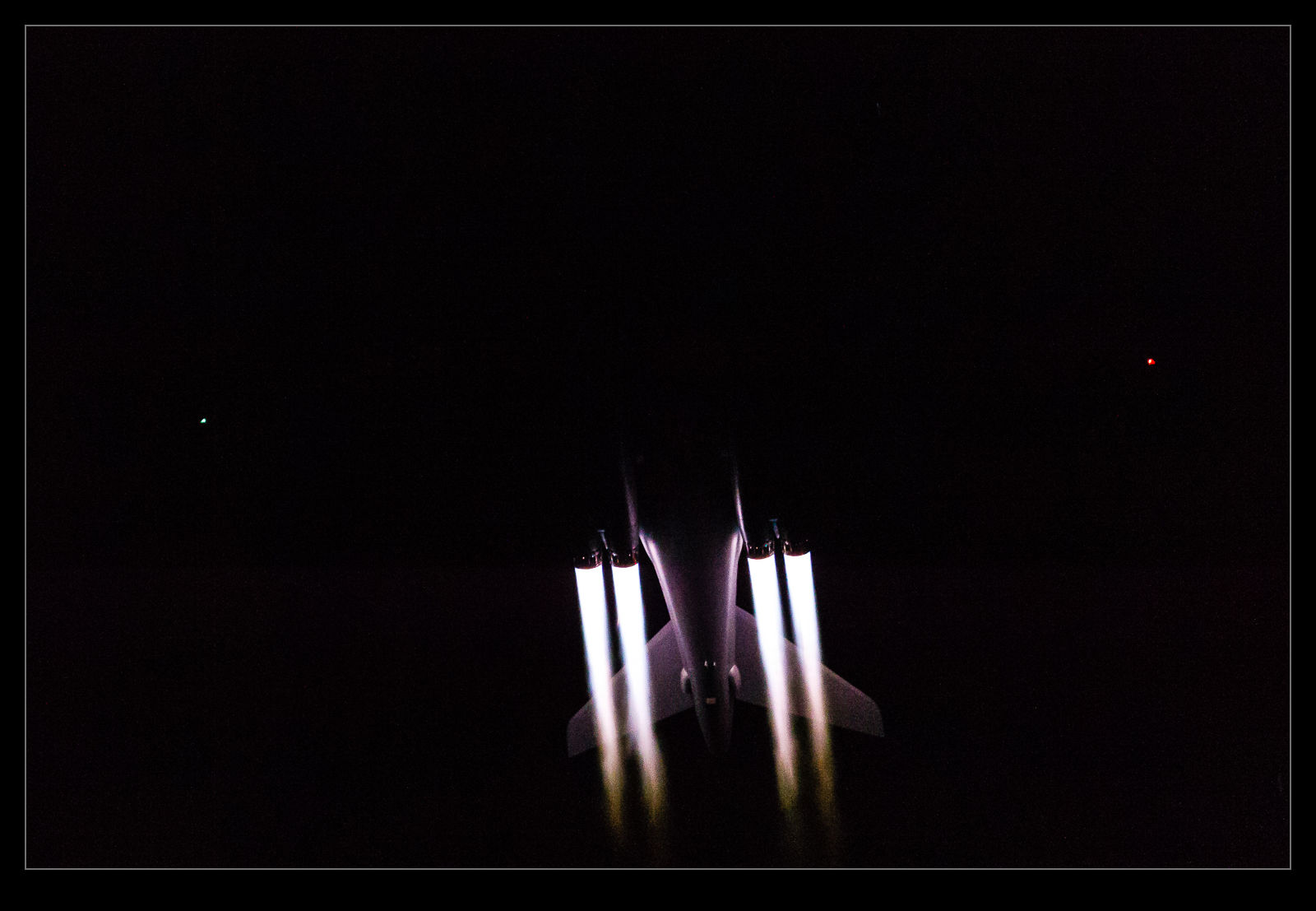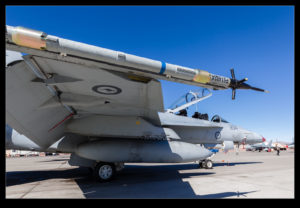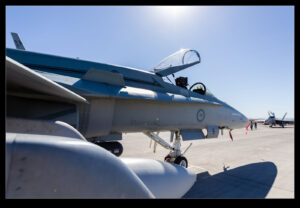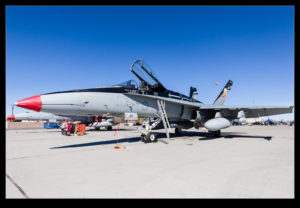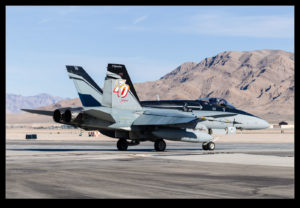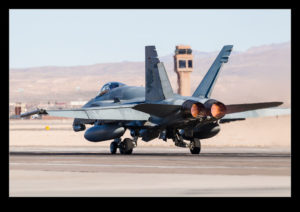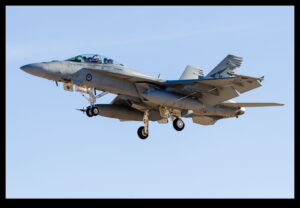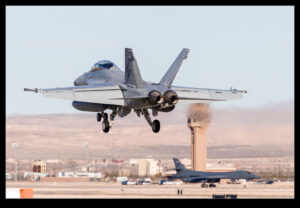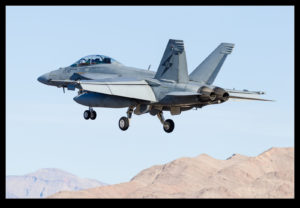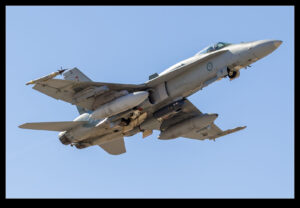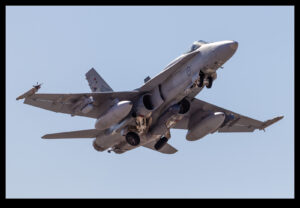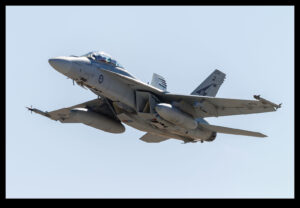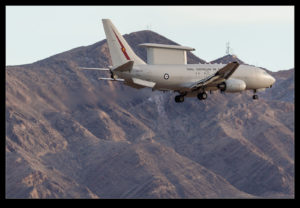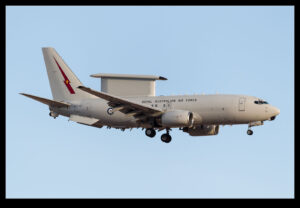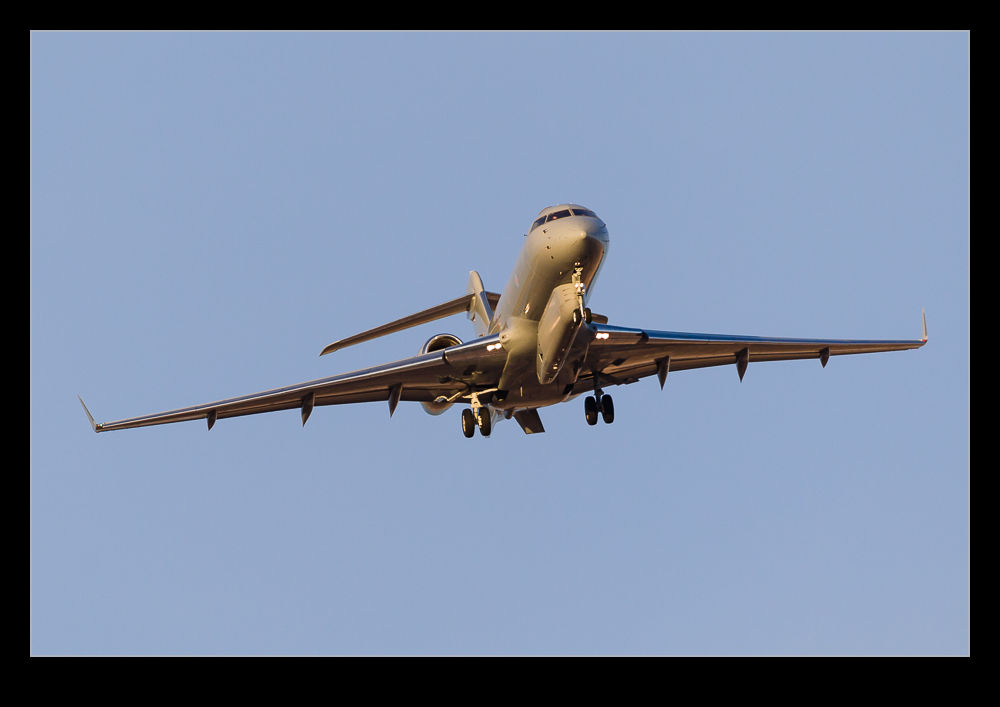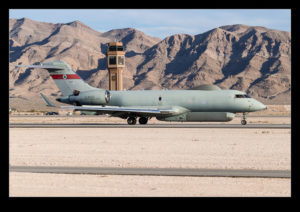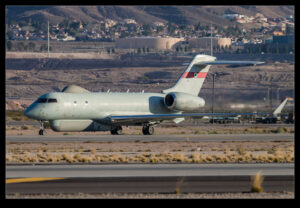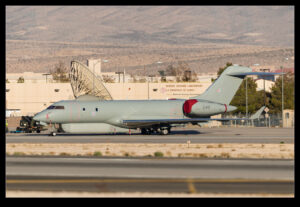I have played with the Zoomify files a few times before. Then I found a way to get a Zoomify file output in HTML5 format rather than Flash. Since so many people are on mobile devices today and plenty of them don’t use Flash, having the new format was necessary to make the output usable widely. I didn’t like the idea of a new page opening up though. Taking people off your page can mean that they don’t come back. Fortunately, I found out how to embed this in an iFrame. Those of you that are web savvy will know all about this stuff but I didn’t. However, messing around with some page code and suddenly my stuff is embedded in the page above. Pretty cool. Feel free to zoom and pan around the Nellis flightline!
Tag Archives: red flag
B-1Bs on a Mission
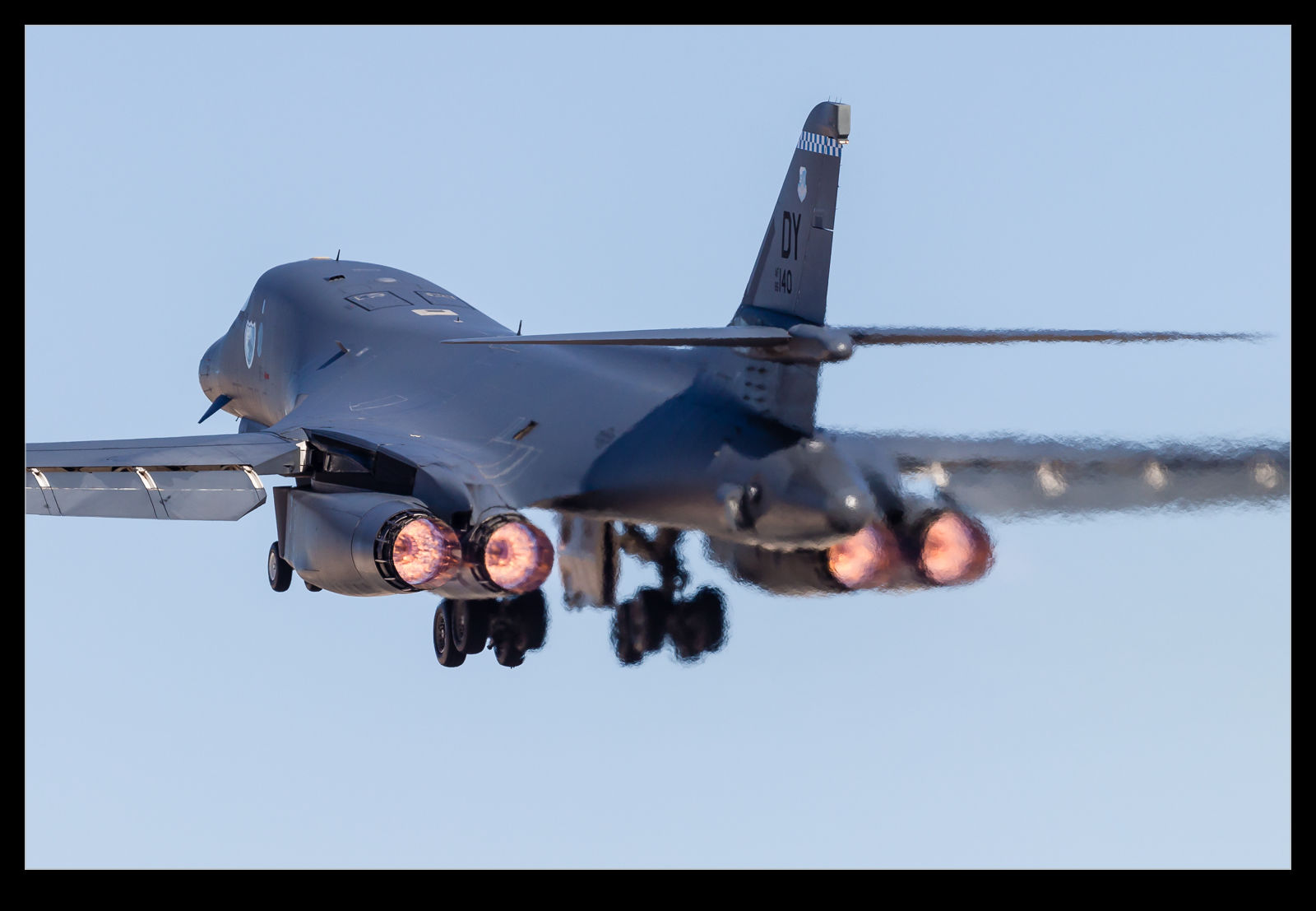 The B-1B Lancer is a cracking aircraft. The combination of size and power makes it look epic when it is in action. A B-1 departure is not something that you will forget in a hurry. Four large afterburning turbofans will get your attention and it has a very elegant shape to boot. The variable sweep wings add a little interest too. At minimum sweep for takeoff and landing, they look a little ungainly given how long the span is. Put them all the way back and pour on the coals and the jet can really get moving. Sadly, airshow appearances are few and far between these days so the chance to see vapor clouds forming around the jet are limited. (I recently went through some old negatives from a UK airshow at which a B-1 made a fast pass in damp conditions. The shots aren’t great but the effect is cool.)
The B-1B Lancer is a cracking aircraft. The combination of size and power makes it look epic when it is in action. A B-1 departure is not something that you will forget in a hurry. Four large afterburning turbofans will get your attention and it has a very elegant shape to boot. The variable sweep wings add a little interest too. At minimum sweep for takeoff and landing, they look a little ungainly given how long the span is. Put them all the way back and pour on the coals and the jet can really get moving. Sadly, airshow appearances are few and far between these days so the chance to see vapor clouds forming around the jet are limited. (I recently went through some old negatives from a UK airshow at which a B-1 made a fast pass in damp conditions. The shots aren’t great but the effect is cool.)
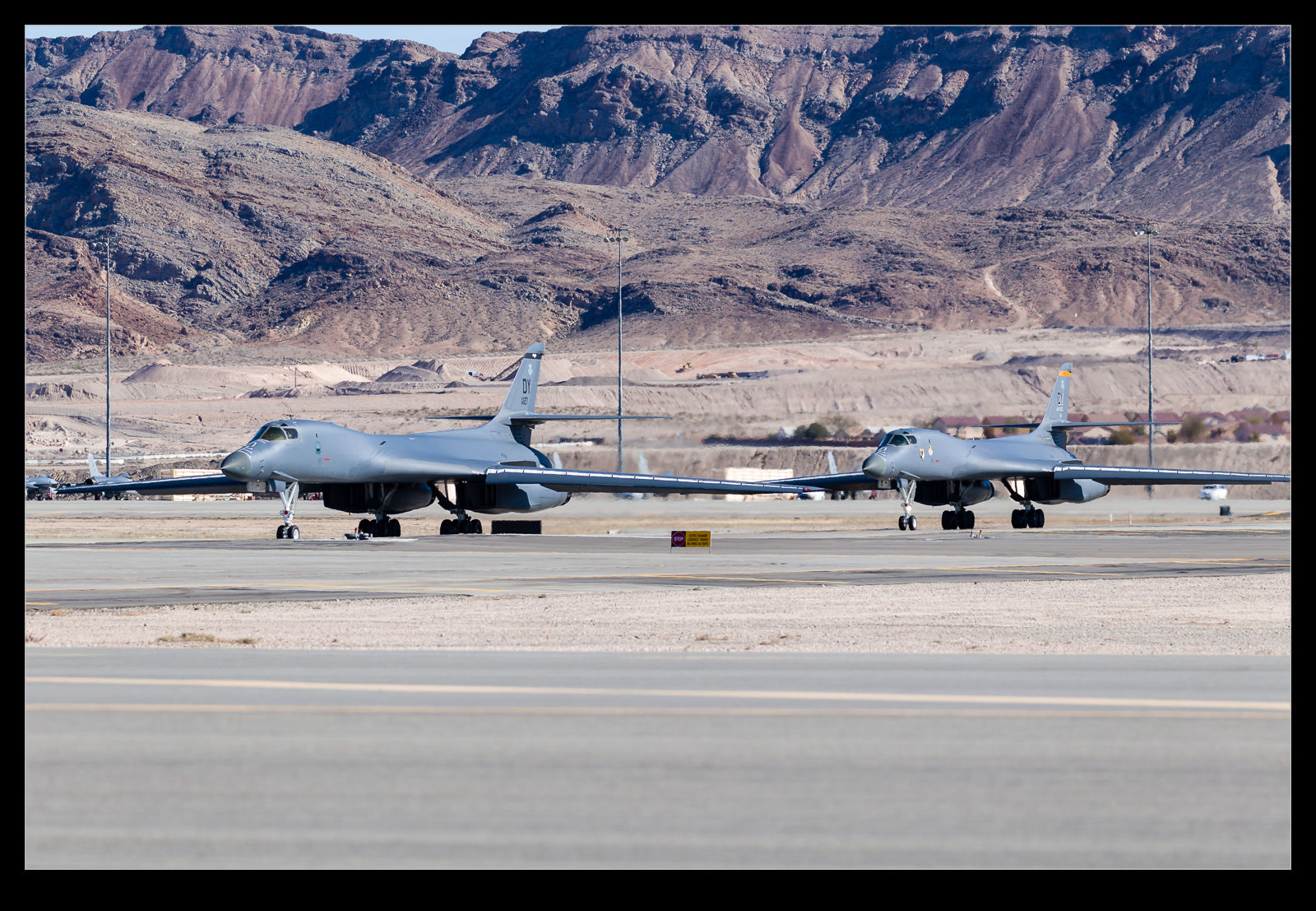 A couple of B-1s would launch each day as part of the Red Flag 16-1 exercises. I was lucky enough to have a couple of good opportunities to see then. When we were out between the runways, the B-1s launched off the right side. Not ideal for lighting but you aren’t going to complain. Because they are a large jet, you have to make some choices with lenses as to what you are aiming to get. A quick swap of bodies can really help. A long lens is not much use when they are level with you but the cool shot from behind as they climb out benefits from the big glass.
A couple of B-1s would launch each day as part of the Red Flag 16-1 exercises. I was lucky enough to have a couple of good opportunities to see then. When we were out between the runways, the B-1s launched off the right side. Not ideal for lighting but you aren’t going to complain. Because they are a large jet, you have to make some choices with lenses as to what you are aiming to get. A quick swap of bodies can really help. A long lens is not much use when they are level with you but the cool shot from behind as they climb out benefits from the big glass.
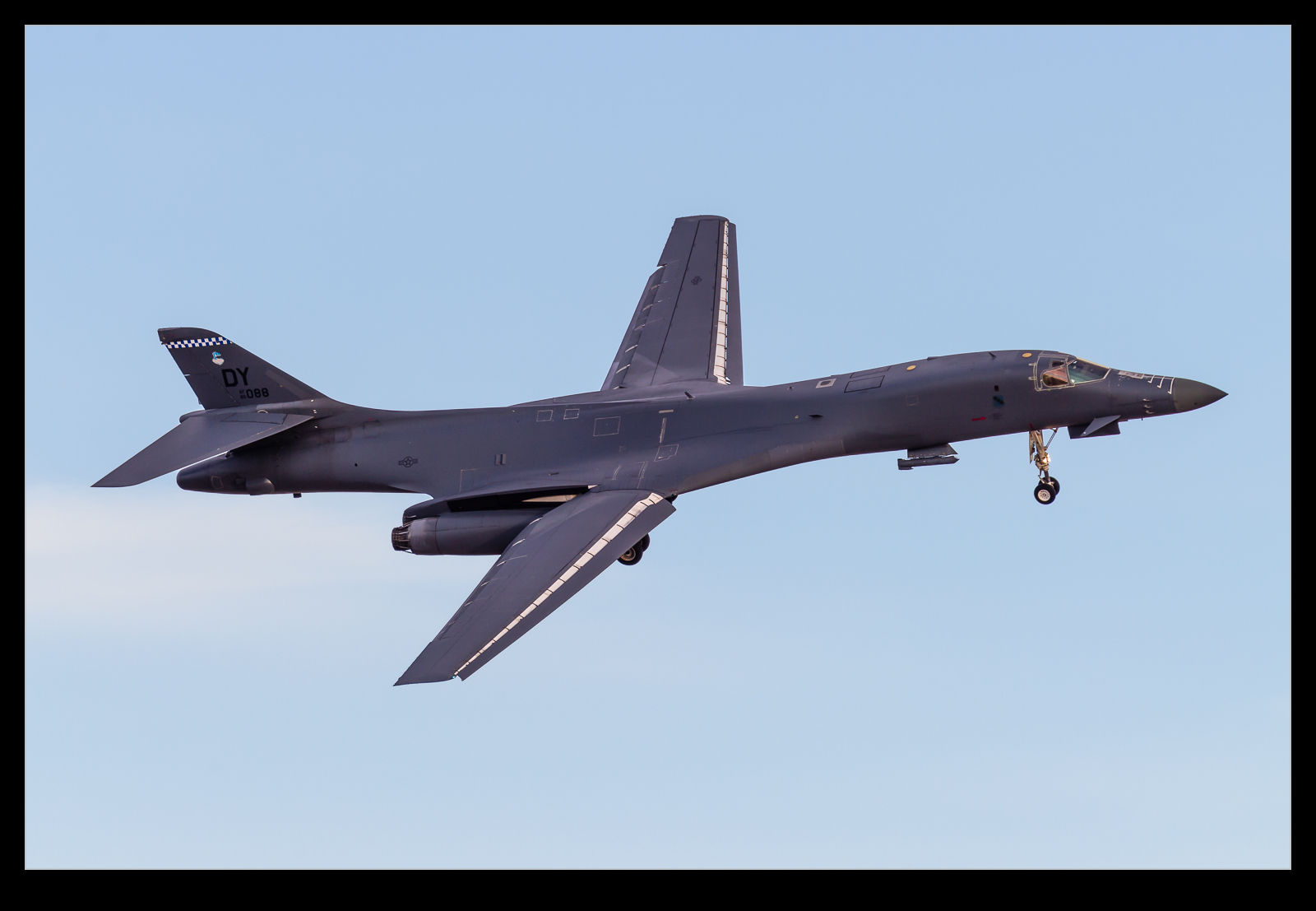 On my first day there, the jets returned at the end of the mission as a pair. Sadly, the clouds had moved in and the conditions were not great for getting a shot. However, you aren’t going to ignore them. On the second day when I was at the EOR, we got a good view of the two jets taxiing out and taking off. The heat haze is a bit of a problem but not so much as to make it something you can avoid shooting. Operating as a pair, they look more menacing.
On my first day there, the jets returned at the end of the mission as a pair. Sadly, the clouds had moved in and the conditions were not great for getting a shot. However, you aren’t going to ignore them. On the second day when I was at the EOR, we got a good view of the two jets taxiing out and taking off. The heat haze is a bit of a problem but not so much as to make it something you can avoid shooting. Operating as a pair, they look more menacing.
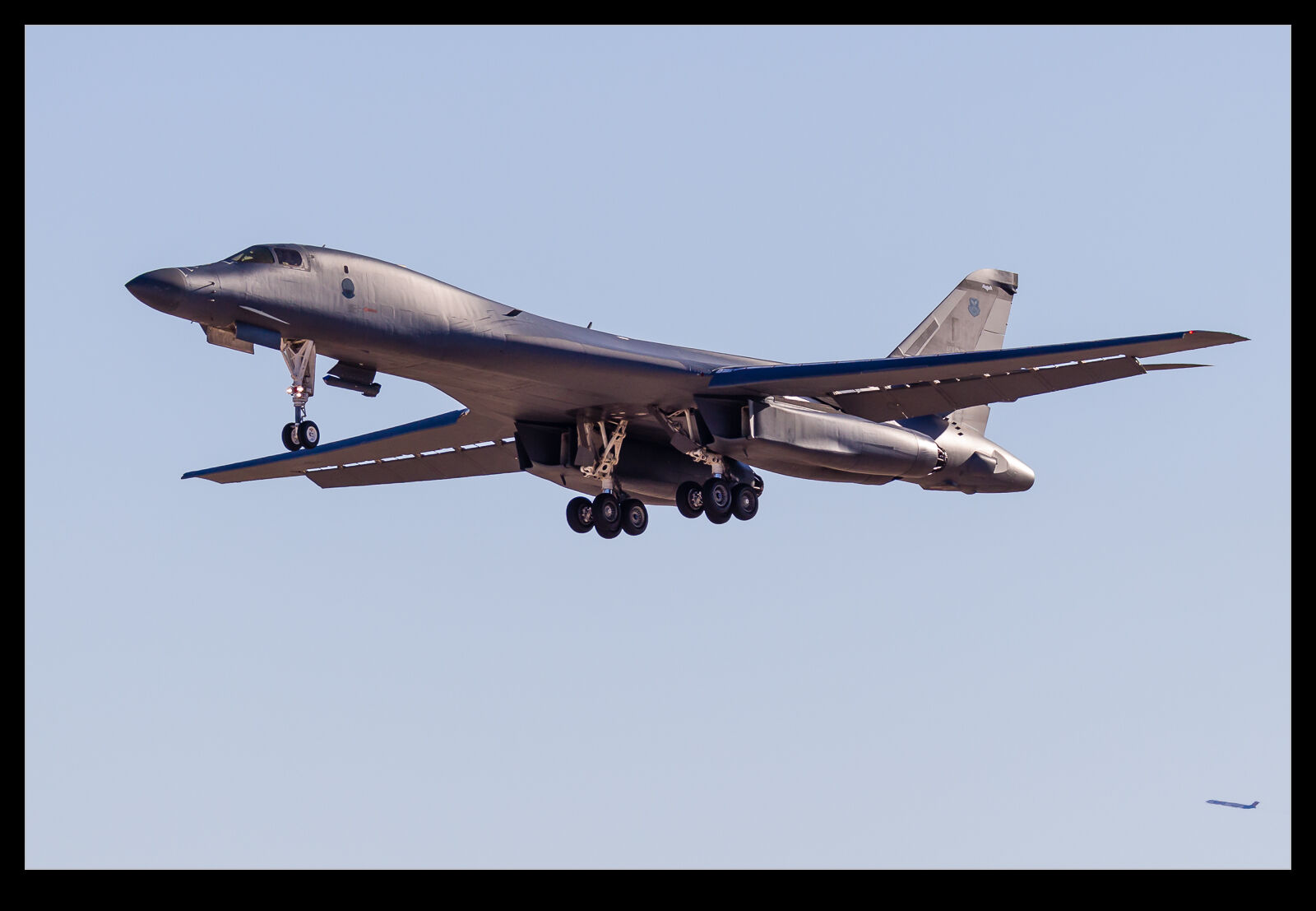 Often the B-1s are at the end of the recovery phase. However, on this day, they came back relatively early. I was still at the EOR when they broke into the pattern. They did land on the opposite runway from the one we were at but they are big enough for this to not be a big deal. A nice bit of mountain in the background certainly helps enhance the shot a little. What a great looking jet. I don’t know anyone who isn’t excited when they see one in action.
Often the B-1s are at the end of the recovery phase. However, on this day, they came back relatively early. I was still at the EOR when they broke into the pattern. They did land on the opposite runway from the one we were at but they are big enough for this to not be a big deal. A nice bit of mountain in the background certainly helps enhance the shot a little. What a great looking jet. I don’t know anyone who isn’t excited when they see one in action.
- A USAF B-1B Lancer on final approach to Nellis AFB Las Vegas Nevada as part of a Red Flag mission.
- A USAF B-1B Lancer on final approach to Nellis AFB Las Vegas Nevada as part of a Red Flag mission.
- A USAF B-1B Lancer overflies Nellis AFB Las Vegas Nevada prior to breaking into the pattern to land after a Red Flag mission.
- Two USAF B-1B Lancers approach the break at Nellis AFB Las Vegas Nevada after a Red Flag mission.
- A Boeing B-1B Lancer of the USAF takes off from Nellis AFB Las Vegas Nevada on a Red Flag Mission.
Back to My Roots with the Typhoons
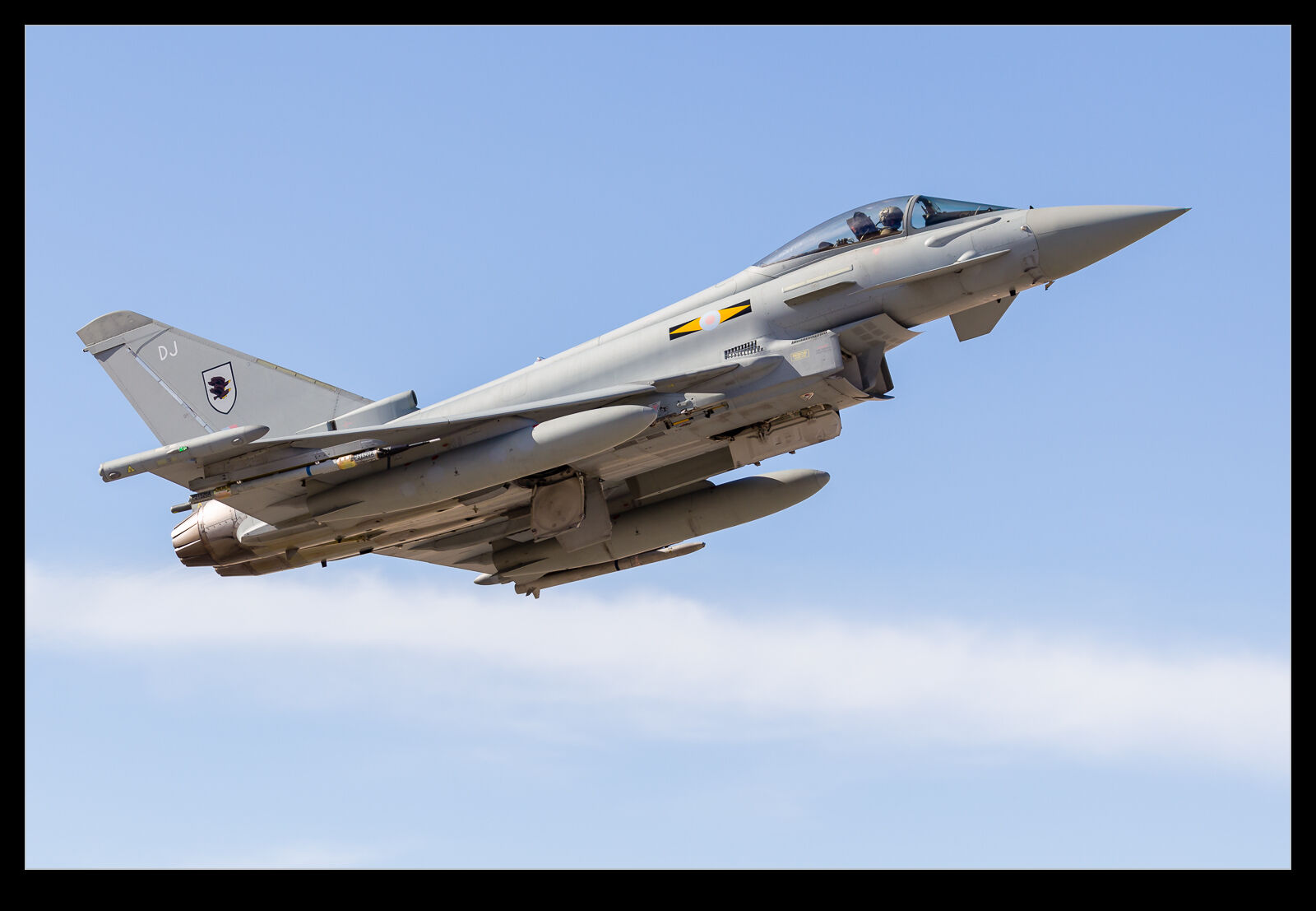 The Brits were at Red Flag in numbers too for 16-1. An E-3D Sentry was part of the AWACS fleet while a C-130J Hercules launched each day I was there. Judging by the dust and dirt on the underside, they were landing on rough strips out on the ranges during their missions. However, the thing I was most looking forward to seeing was the Typhoon. The RAF brought eight jets from 3 and 11 Squadrons. Most days six of them launched.
The Brits were at Red Flag in numbers too for 16-1. An E-3D Sentry was part of the AWACS fleet while a C-130J Hercules launched each day I was there. Judging by the dust and dirt on the underside, they were landing on rough strips out on the ranges during their missions. However, the thing I was most looking forward to seeing was the Typhoon. The RAF brought eight jets from 3 and 11 Squadrons. Most days six of them launched.
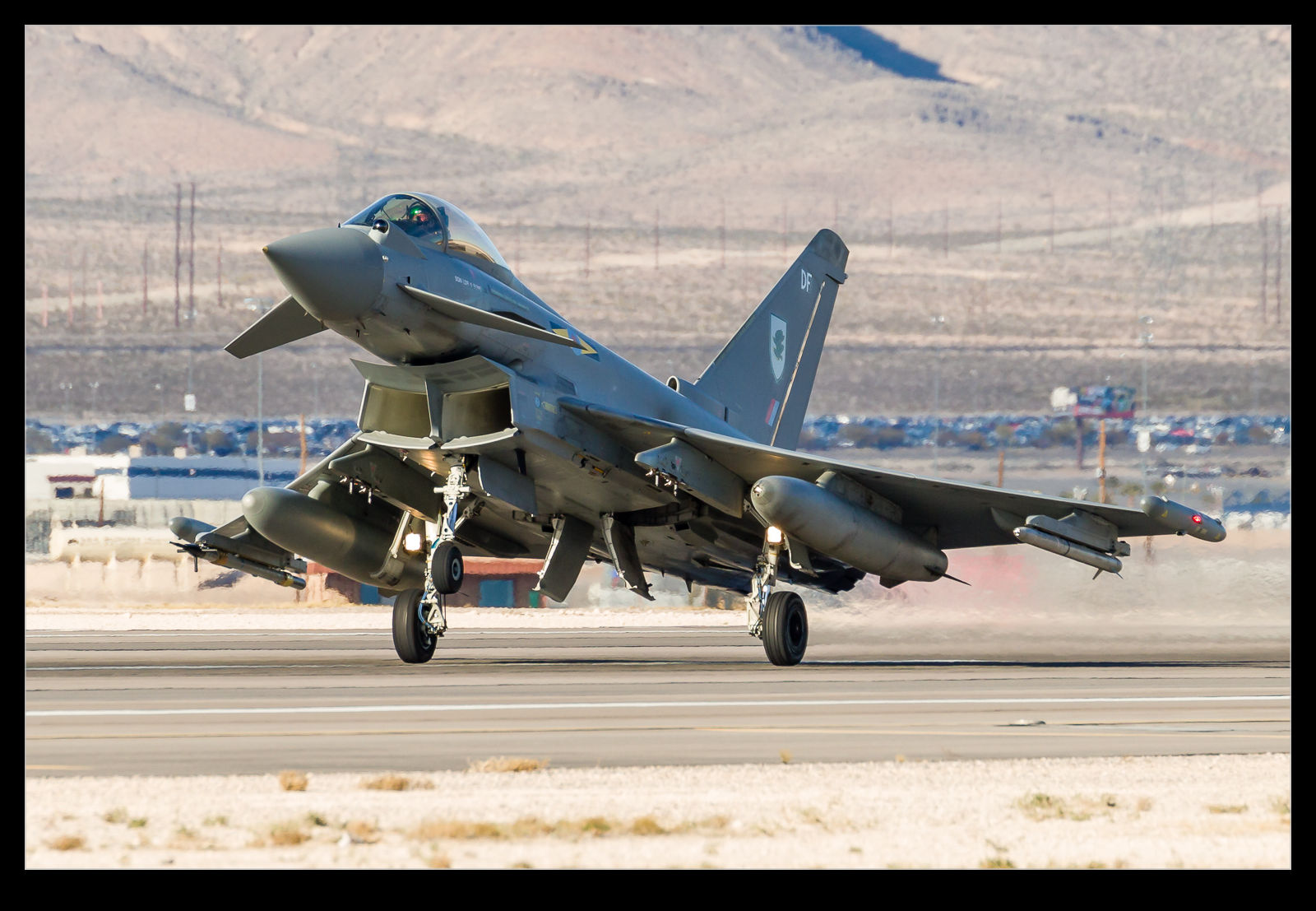 In my youth, I worked on what was to become the Typhoon in my BAE days. I was an aerodynamicist looking at airframe loading and the possible flight envelope for the first flight. I was not looking forward to the job when I was given it but working on loads turned out to be a great task and taught me a lot about structural limits, flight controls and the process for expanding the flight envelope. A mentor of mine had told me it sounded dull but was very valuable and he was spot on. I guess he is a smart guy because he has gone on to be rather successful in the company!
In my youth, I worked on what was to become the Typhoon in my BAE days. I was an aerodynamicist looking at airframe loading and the possible flight envelope for the first flight. I was not looking forward to the job when I was given it but working on loads turned out to be a great task and taught me a lot about structural limits, flight controls and the process for expanding the flight envelope. A mentor of mine had told me it sounded dull but was very valuable and he was spot on. I guess he is a smart guy because he has gone on to be rather successful in the company!
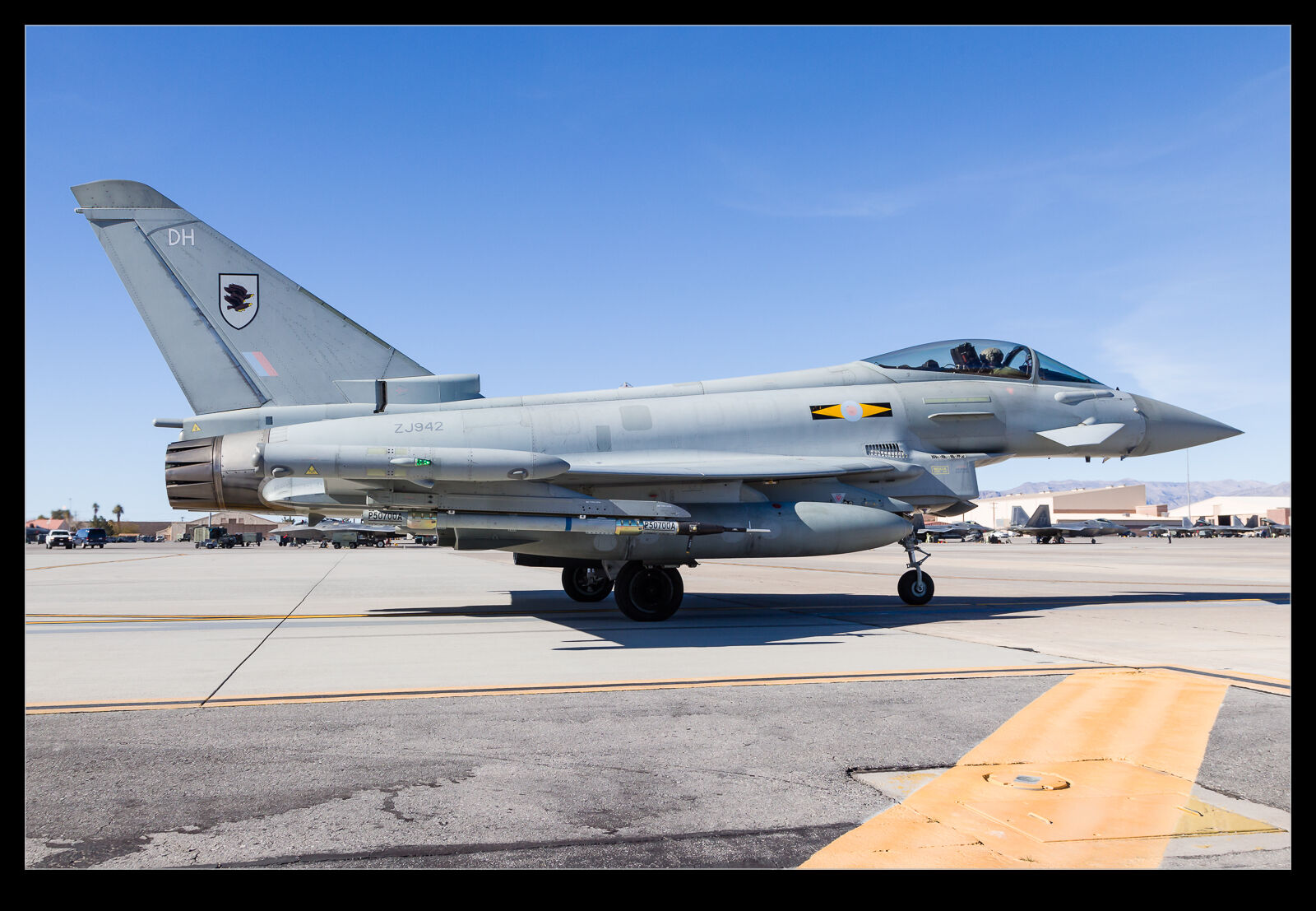 Back on topic, the Typhoon is something I am very pleased to have worked on. Getting to see them in action is great. The launches when we were out by the runways were great. When we were by the EOR, we were directly across from the ramp that the Typhoons were using so I managed to see them crewing up for the launch. Then, of course, they had to come right by us as they taxied out. I know it was a long time ago but I can’t help but still have a soft spot for them when I see them in use.
Back on topic, the Typhoon is something I am very pleased to have worked on. Getting to see them in action is great. The launches when we were out by the runways were great. When we were by the EOR, we were directly across from the ramp that the Typhoons were using so I managed to see them crewing up for the launch. Then, of course, they had to come right by us as they taxied out. I know it was a long time ago but I can’t help but still have a soft spot for them when I see them in use.
- Two Royal Air Force Typhoon fighters make final checks on the ramp at Nellis AFB Las Vegas Nevada as part of a Red Flag mission.
- A Royal Air Force Typhoon fighter on final approach to Nellis AFB Las Vegas Nevada as part of a Red Flag mission.
- Two Royal Air Force Typhoon fighters await takeoff clearance at Nellis AFB Las Vegas Nevada as part of a Red Flag mission.
- A Royal Air Force Eurofighter Typhoon turns on to final approach at Nellis AFB Las Vegas Nevada after a Red Flag mission.
- A Royal Air Force Eurofighter Typhoon turns on to final approach at Nellis AFB Las Vegas Nevada after a Red Flag mission.
Two Aborts in One Launch
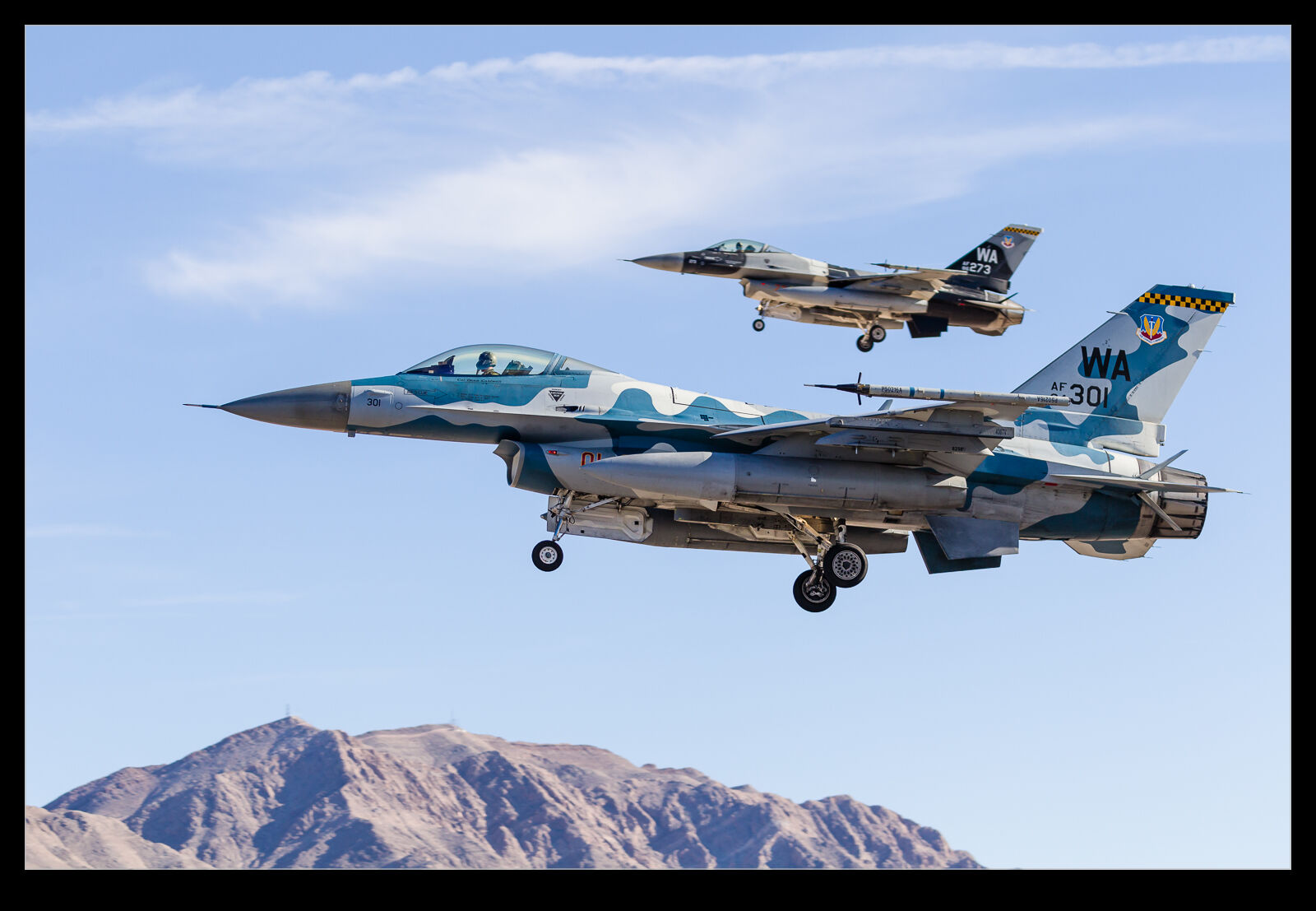 Red Flag missions are two periods of intense activity with an intermediate phase of nothing much. The launch develops in to a steady stream of jets taking off as everyone gets airborne for their phase of the mission. They have been preceded by the tankers and AWACS who are setting up to manage the throughout of the smaller jets. Once everyone is gone, the simulated war is occurring somewhere else. Then, everything starts to come back with a steady stream of the jets breaking overhead and landing before the tankers and AWACS come back at the end.
Red Flag missions are two periods of intense activity with an intermediate phase of nothing much. The launch develops in to a steady stream of jets taking off as everyone gets airborne for their phase of the mission. They have been preceded by the tankers and AWACS who are setting up to manage the throughout of the smaller jets. Once everyone is gone, the simulated war is occurring somewhere else. Then, everything starts to come back with a steady stream of the jets breaking overhead and landing before the tankers and AWACS come back at the end.
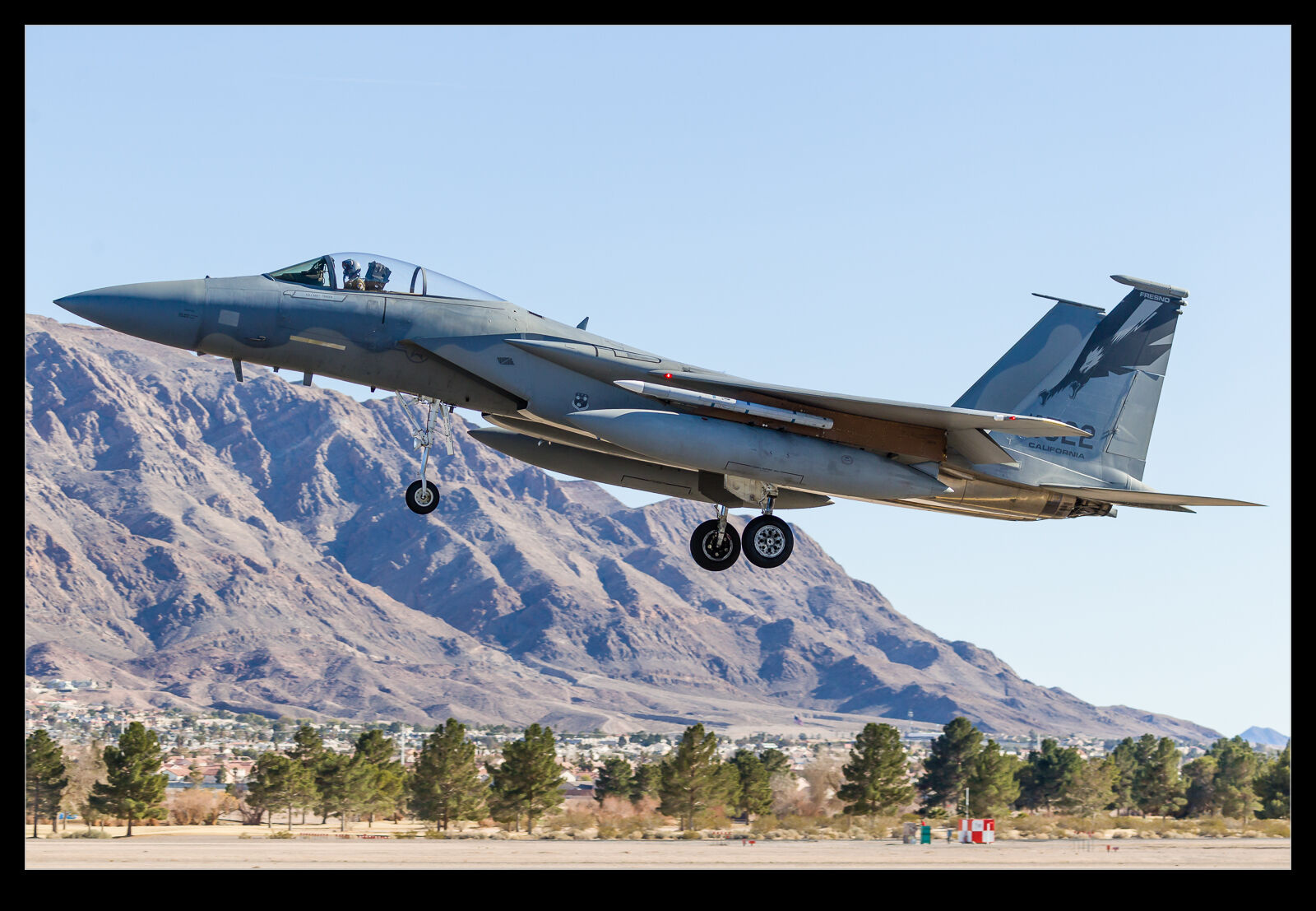 After the majority of the launch, we were at the EOR watching the occasional straggler go out or some based planes fitting in. Then we got a pair of F-15s come back. They flew an approach with one jet on the glide path while the other was clearly shepherding them in. The F-15 landed without incident and the wingman powered away to rejoin the flight. Some fire trucks rolled but everything seemed to be under control.
After the majority of the launch, we were at the EOR watching the occasional straggler go out or some based planes fitting in. Then we got a pair of F-15s come back. They flew an approach with one jet on the glide path while the other was clearly shepherding them in. The F-15 landed without incident and the wingman powered away to rejoin the flight. Some fire trucks rolled but everything seemed to be under control.
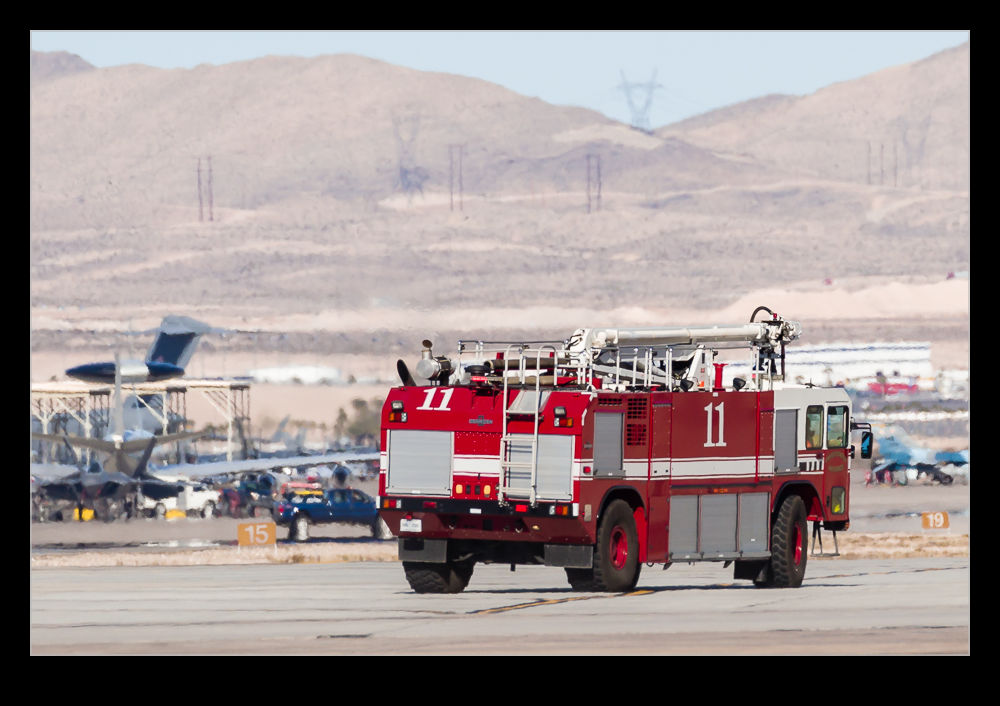 Not long after we had stopped discussing this, a pair of aggressor F-16s came into view. The same procedure and one landed while the other shadowed them down the approach. With a safe touchdown, power on and back to the battle. Technical issues are not uncommon but I was surprised to get two in close succession. Everyone seems to have handled them appropriately and they appear to have ended without further incident.
Not long after we had stopped discussing this, a pair of aggressor F-16s came into view. The same procedure and one landed while the other shadowed them down the approach. With a safe touchdown, power on and back to the battle. Technical issues are not uncommon but I was surprised to get two in close succession. Everyone seems to have handled them appropriately and they appear to have ended without further incident.
Red Flag 16-1 Launch
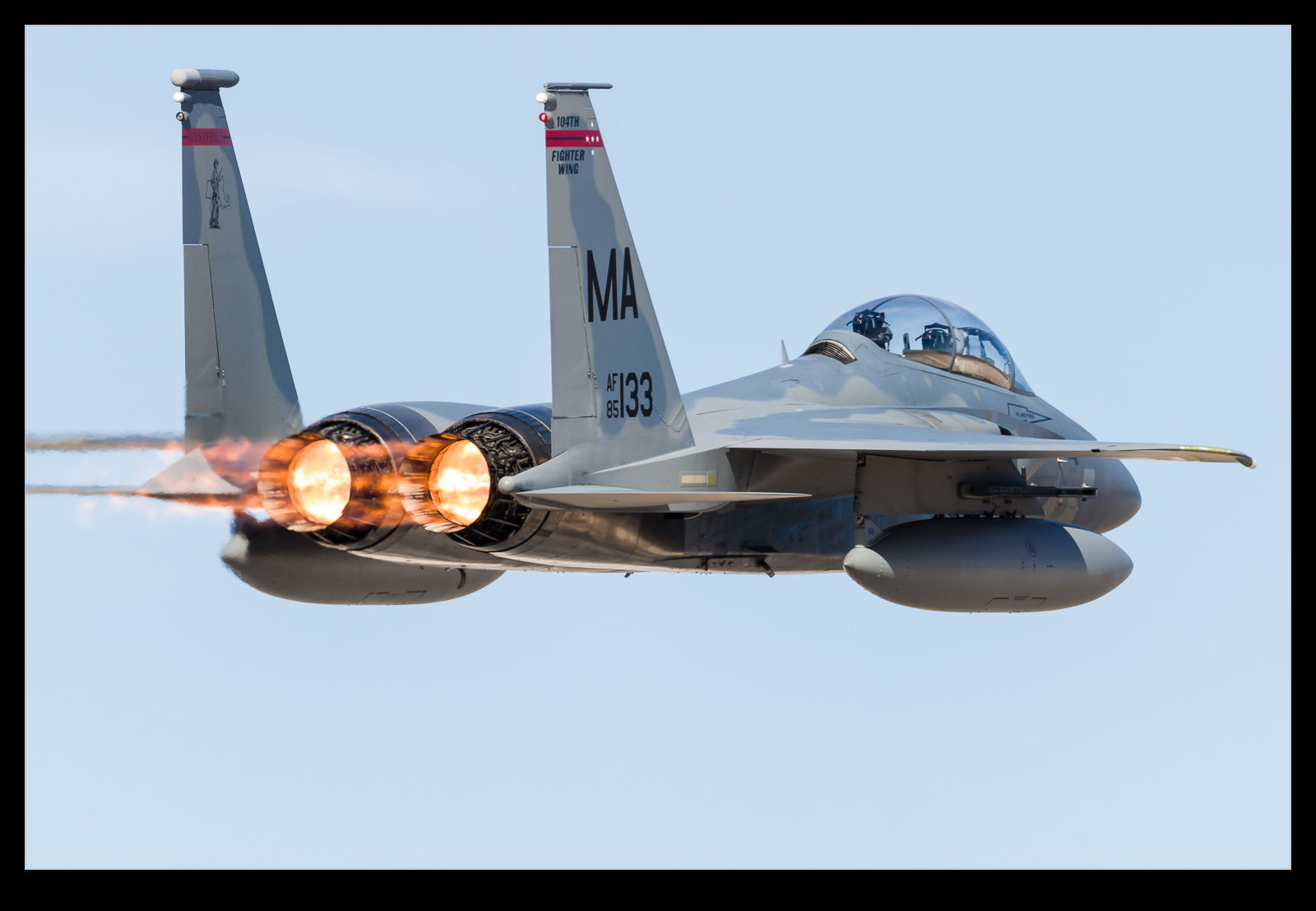 I might not be as regular at Red Flag exercises as some of my colleagues but I do try and get to at least one a year. The different events have differing levels of appeal. The winter means less hot weather but the sun angles can be very tricky. Sometimes there is a lack of overseas participation. In the case of 16-1, there was a planned attendance from the Royal Australian Air Force with a variety of types as well as the RAF bringing Typhoons and a Hercules. My UK friends would be interested in the other participants but I like to see the RAF stuff because I don’t normally see it.
I might not be as regular at Red Flag exercises as some of my colleagues but I do try and get to at least one a year. The different events have differing levels of appeal. The winter means less hot weather but the sun angles can be very tricky. Sometimes there is a lack of overseas participation. In the case of 16-1, there was a planned attendance from the Royal Australian Air Force with a variety of types as well as the RAF bringing Typhoons and a Hercules. My UK friends would be interested in the other participants but I like to see the RAF stuff because I don’t normally see it.
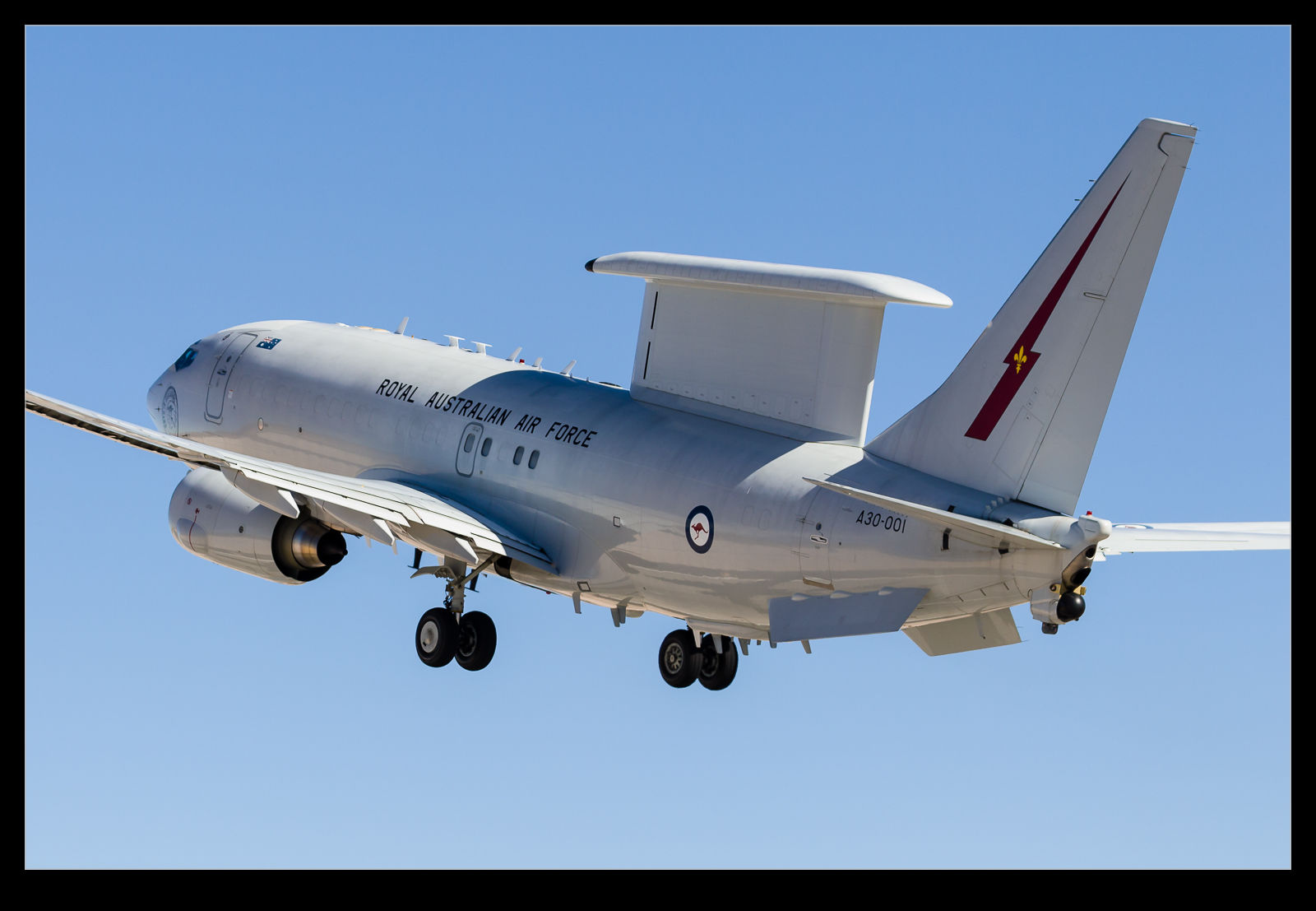 Launches follow a pretty regular pattern. The AEW aircraft gets up first followed by the tankers. Then the bombers head up and the rest of the aircraft stream out. They tend to launch to the northeast and recover in the opposite direction. The launch means a lot of backlighting of the aircraft. There have been times when they launch to the southwest but, sadly, I have never been there for one of those. Recoveries are into the light usually which helps. Unfortunately, some changes in the procedures meant that we did not get a full recovery on base.
Launches follow a pretty regular pattern. The AEW aircraft gets up first followed by the tankers. Then the bombers head up and the rest of the aircraft stream out. They tend to launch to the northeast and recover in the opposite direction. The launch means a lot of backlighting of the aircraft. There have been times when they launch to the southwest but, sadly, I have never been there for one of those. Recoveries are into the light usually which helps. Unfortunately, some changes in the procedures meant that we did not get a full recovery on base.
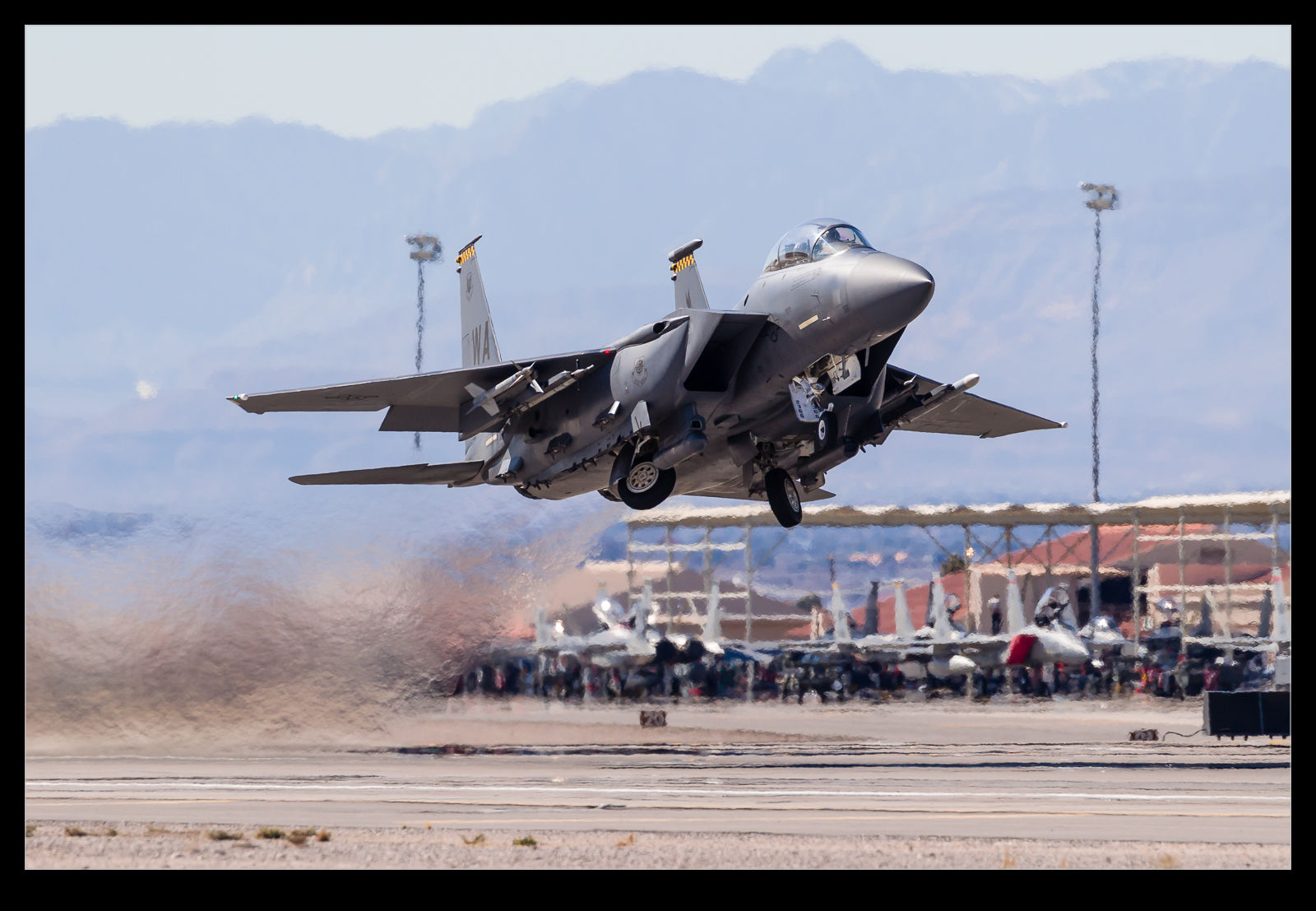 We were quite lucky as the following day the winds picked up and the recoveries were made in the same direction as the launch which would not have made for good photo opportunities. The launch is always an interesting challenge. They launch from both runways so you find yourself deciding which side is going next and scurrying back and forth. You also have some aircraft on the banned list so you have to make sure you know what each plane is before you shoot it. This can involve being able to shoot one unit’s aircraft of a given type but not another’s. Still, it’s better than being at work.
We were quite lucky as the following day the winds picked up and the recoveries were made in the same direction as the launch which would not have made for good photo opportunities. The launch is always an interesting challenge. They launch from both runways so you find yourself deciding which side is going next and scurrying back and forth. You also have some aircraft on the banned list so you have to make sure you know what each plane is before you shoot it. This can involve being able to shoot one unit’s aircraft of a given type but not another’s. Still, it’s better than being at work.
ASRAAM Self Portrait
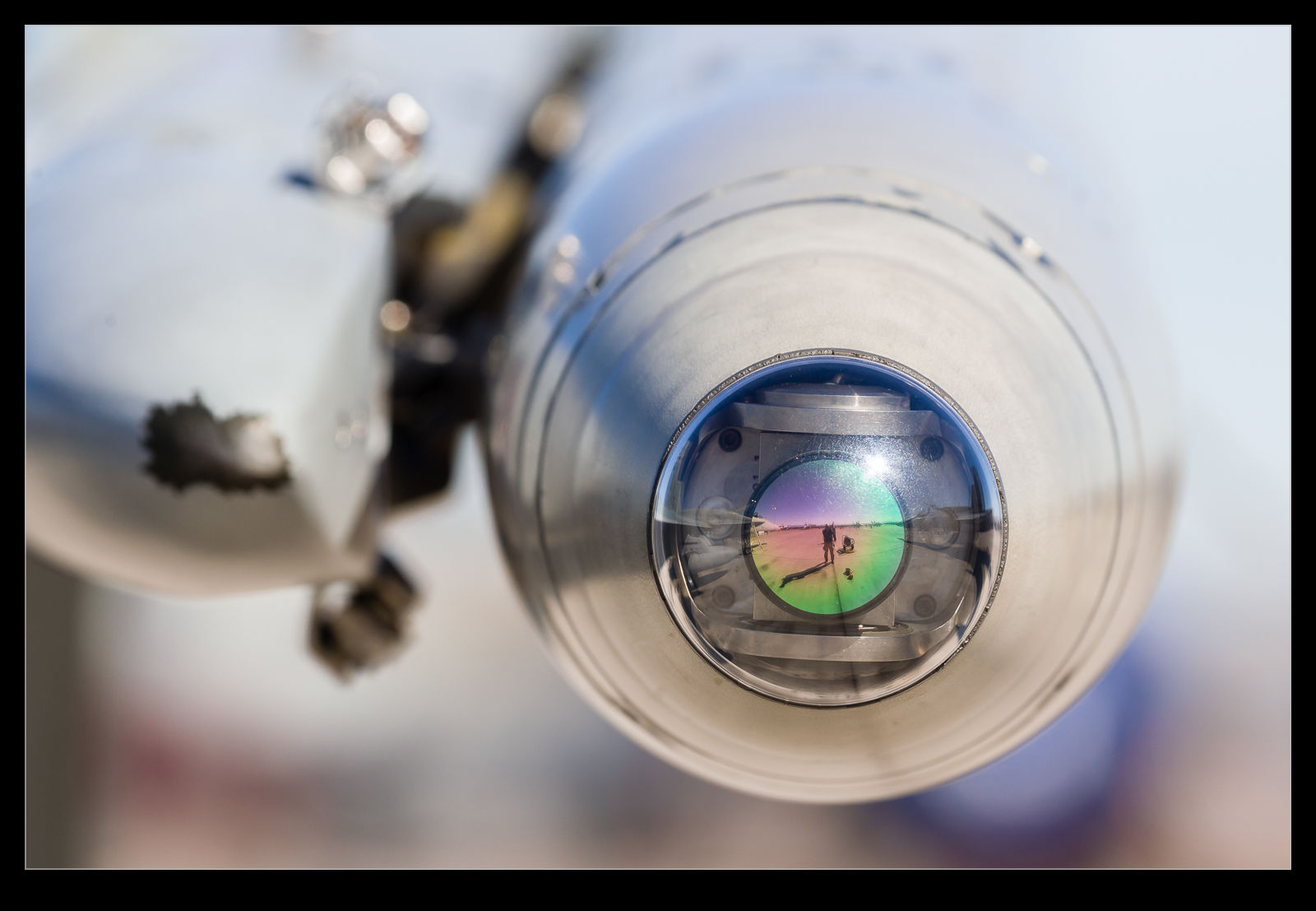 While waking along the ramp occupied by the RAAF Hornets, one of the ASRAAM missiles on the wingtip launch rail of an A-model Hornet had its seeker cover removed. It was dangling by a strap and I was going to ask one of the ground crew if we should replace it. Then I got distracted by the seeker itself. It looked pretty cool and was reflecting light in an interesting way. Naturally, when you are near something reflective, the idea of a self-portrait jumps to mind if you are a little self-obsessed so I couldn’t help myself. Many years ago I worked on an ASRAAM seeker development related task using the company Jetstream testbed so I can pretend all of this is a technical interest and not narcissism at all.
While waking along the ramp occupied by the RAAF Hornets, one of the ASRAAM missiles on the wingtip launch rail of an A-model Hornet had its seeker cover removed. It was dangling by a strap and I was going to ask one of the ground crew if we should replace it. Then I got distracted by the seeker itself. It looked pretty cool and was reflecting light in an interesting way. Naturally, when you are near something reflective, the idea of a self-portrait jumps to mind if you are a little self-obsessed so I couldn’t help myself. Many years ago I worked on an ASRAAM seeker development related task using the company Jetstream testbed so I can pretend all of this is a technical interest and not narcissism at all.
Another Night Launch on a Cold and Windy Night
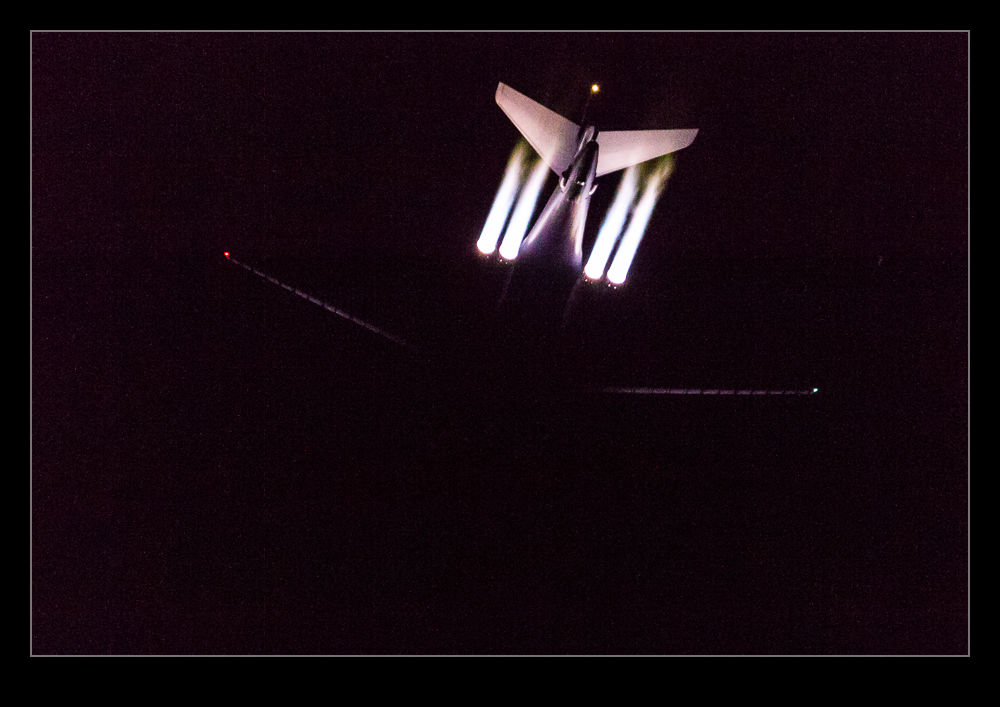 The evening launch at Red Flag is something I have had a go at on a number of occasions. Consequently, regular readers that pay close attention may feel that this post is a bit repetitive and they would be correct. I was a bit better prepared for the night launch than on previous occasions. I had brought a cable release and a Gorillapod to allow me to have a bit better a set up for the time lapse video of the launch. Meanwhile, I was shooting handheld with the second body.
The evening launch at Red Flag is something I have had a go at on a number of occasions. Consequently, regular readers that pay close attention may feel that this post is a bit repetitive and they would be correct. I was a bit better prepared for the night launch than on previous occasions. I had brought a cable release and a Gorillapod to allow me to have a bit better a set up for the time lapse video of the launch. Meanwhile, I was shooting handheld with the second body.
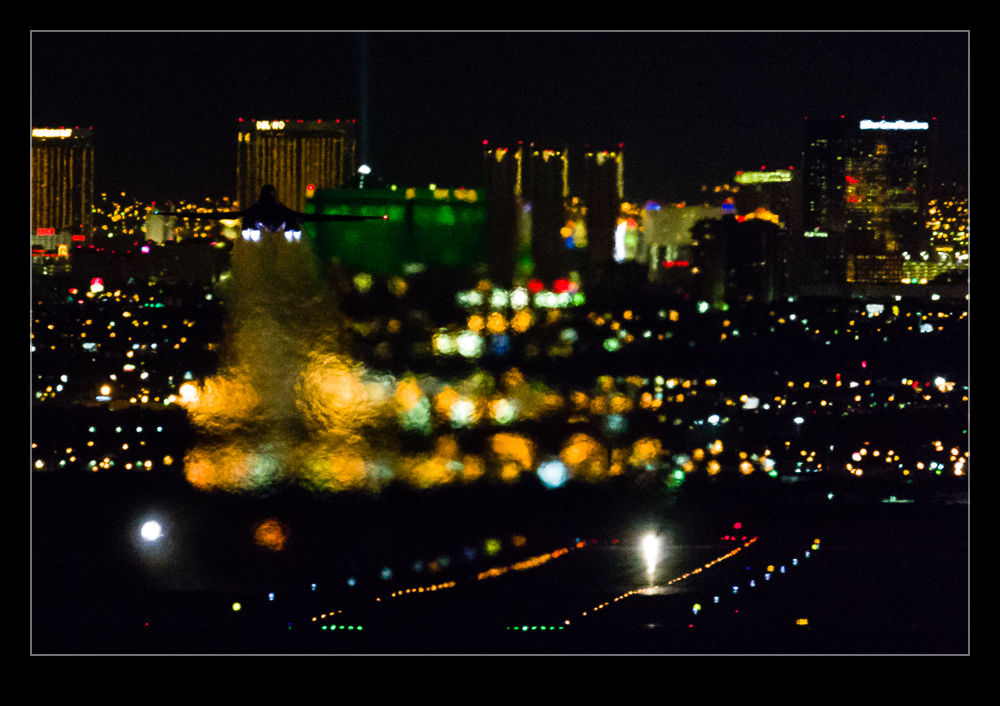 Sadly, a couple of things were not working in my favor. First, it was pretty windy and, while I had the camera set up on the hood of the car, it was a bit vulnerable to movement as the car moved in the wind and the camera vibrated on the pod. Consequently, some of the video is less than ideal. However, conditions did seem to settle down a bit and the later part of the video seems to steady up a bit.
Sadly, a couple of things were not working in my favor. First, it was pretty windy and, while I had the camera set up on the hood of the car, it was a bit vulnerable to movement as the car moved in the wind and the camera vibrated on the pod. Consequently, some of the video is less than ideal. However, conditions did seem to settle down a bit and the later part of the video seems to steady up a bit.
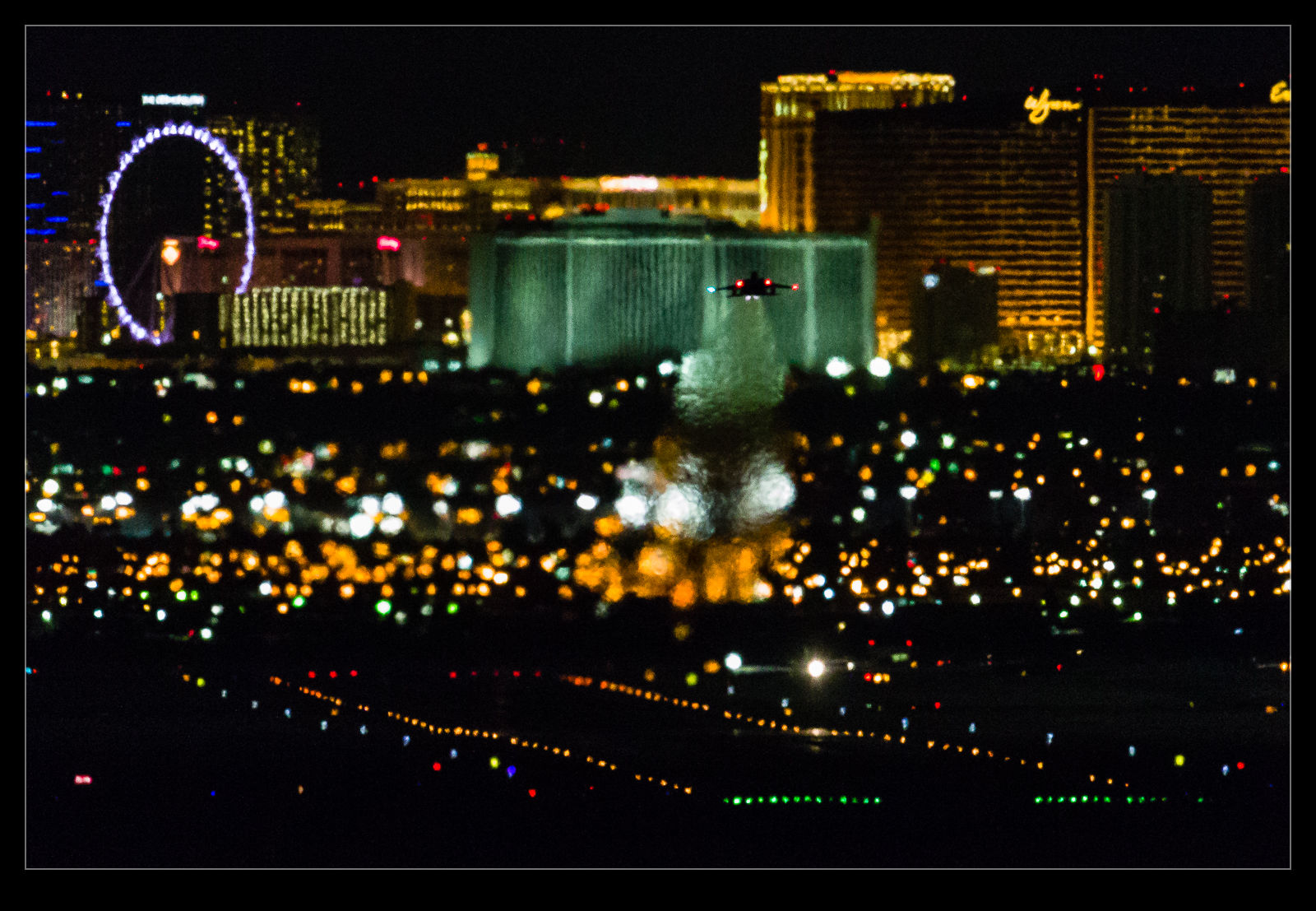 Second was that there was no moon. It was very dark and cold out there. I managed to get some shots of the B-1B launches but the only illumination was from the burners. No ambient light at all so they didn’t look as good as on previous attempts. I did try to stay for the whole launch and not to get the time lapse showing things in full swing when it ends but there is a limit to how long you want to hang out in the cold when everyone else has gone. I got most of the launch but I did see a bunch of jets head out as I passed the speedway. I probably should have tried getting some shots from there as they were still in burner at that point.
Second was that there was no moon. It was very dark and cold out there. I managed to get some shots of the B-1B launches but the only illumination was from the burners. No ambient light at all so they didn’t look as good as on previous attempts. I did try to stay for the whole launch and not to get the time lapse showing things in full swing when it ends but there is a limit to how long you want to hang out in the cold when everyone else has gone. I got most of the launch but I did see a bunch of jets head out as I passed the speedway. I probably should have tried getting some shots from there as they were still in burner at that point.
A Feel for the EOR
During the recent Red Flag 16-1, which I was covering for Global Aviation Resource, I got to spend a portion of the day at the South EOR. EOR means end of the runway and this is where the planes come prior to taking off. They go through their final checks before launching and we get to be very close to them. I was mainly taking stills for the GAR feature but I got some video while I was there. I wanted to have something that shows what it feels like and how close we were. Consequently, some of the shots involve my fellow photographers so you can have some context of where we were.
The Aussies Are in Town
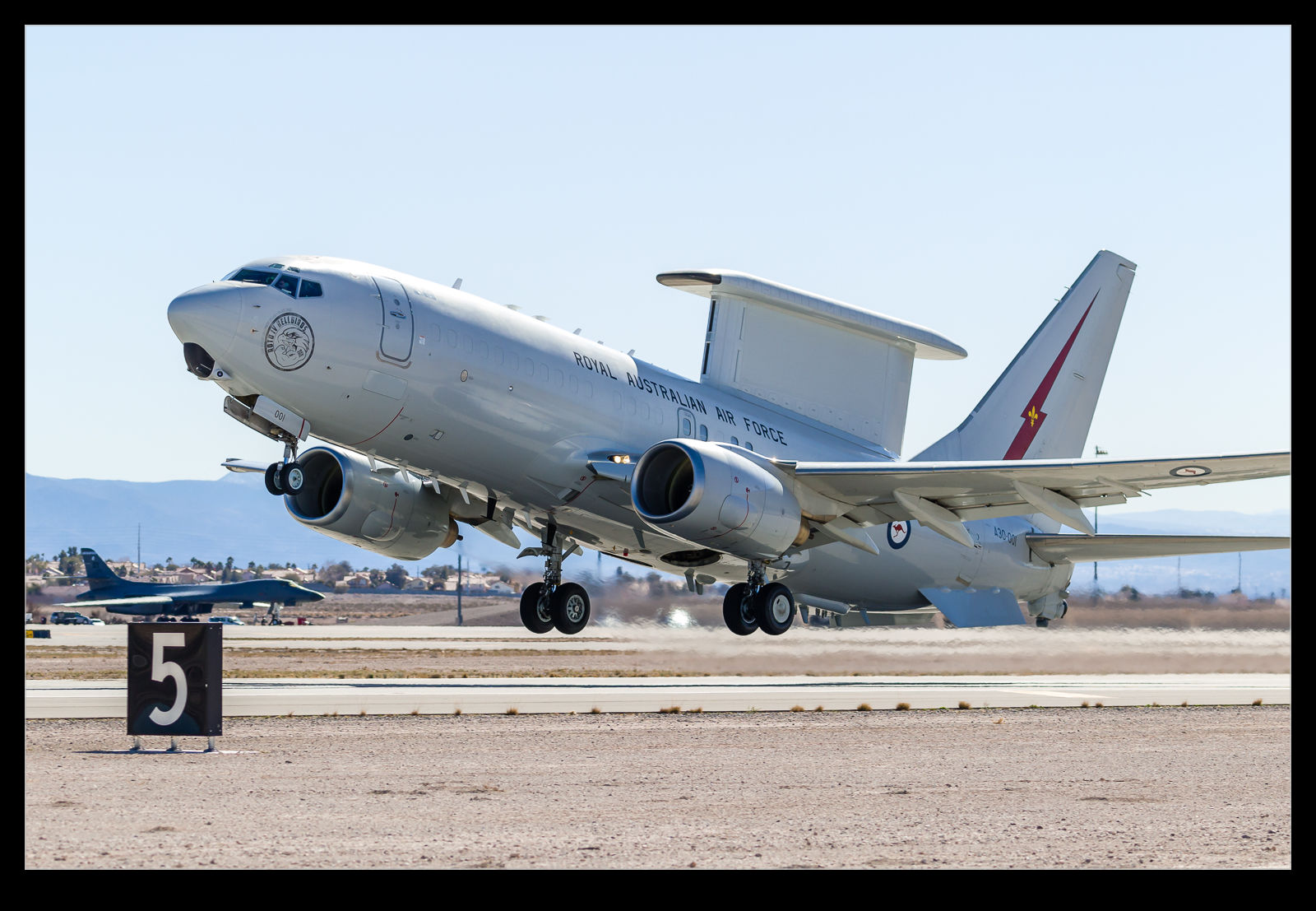 One of the things that I was really looking forward to about Red Flag 16-1 was the large Australian contingent that was going to be present. The Aussies were coming with Hornets and Super Hornets as well as a P-3 and an E-7 Wedgetail. They were also tanked across by a KC-30 although that sadly went somewhere else so I didn’t see it while I was there. Another benefit of the Aussies is that they bring some fun to the media panel. Sometimes these can be rather dull affairs and like pulling teeth. Previous RAAF officers have been very chatty and informative. This time was no exception.
One of the things that I was really looking forward to about Red Flag 16-1 was the large Australian contingent that was going to be present. The Aussies were coming with Hornets and Super Hornets as well as a P-3 and an E-7 Wedgetail. They were also tanked across by a KC-30 although that sadly went somewhere else so I didn’t see it while I was there. Another benefit of the Aussies is that they bring some fun to the media panel. Sometimes these can be rather dull affairs and like pulling teeth. Previous RAAF officers have been very chatty and informative. This time was no exception.
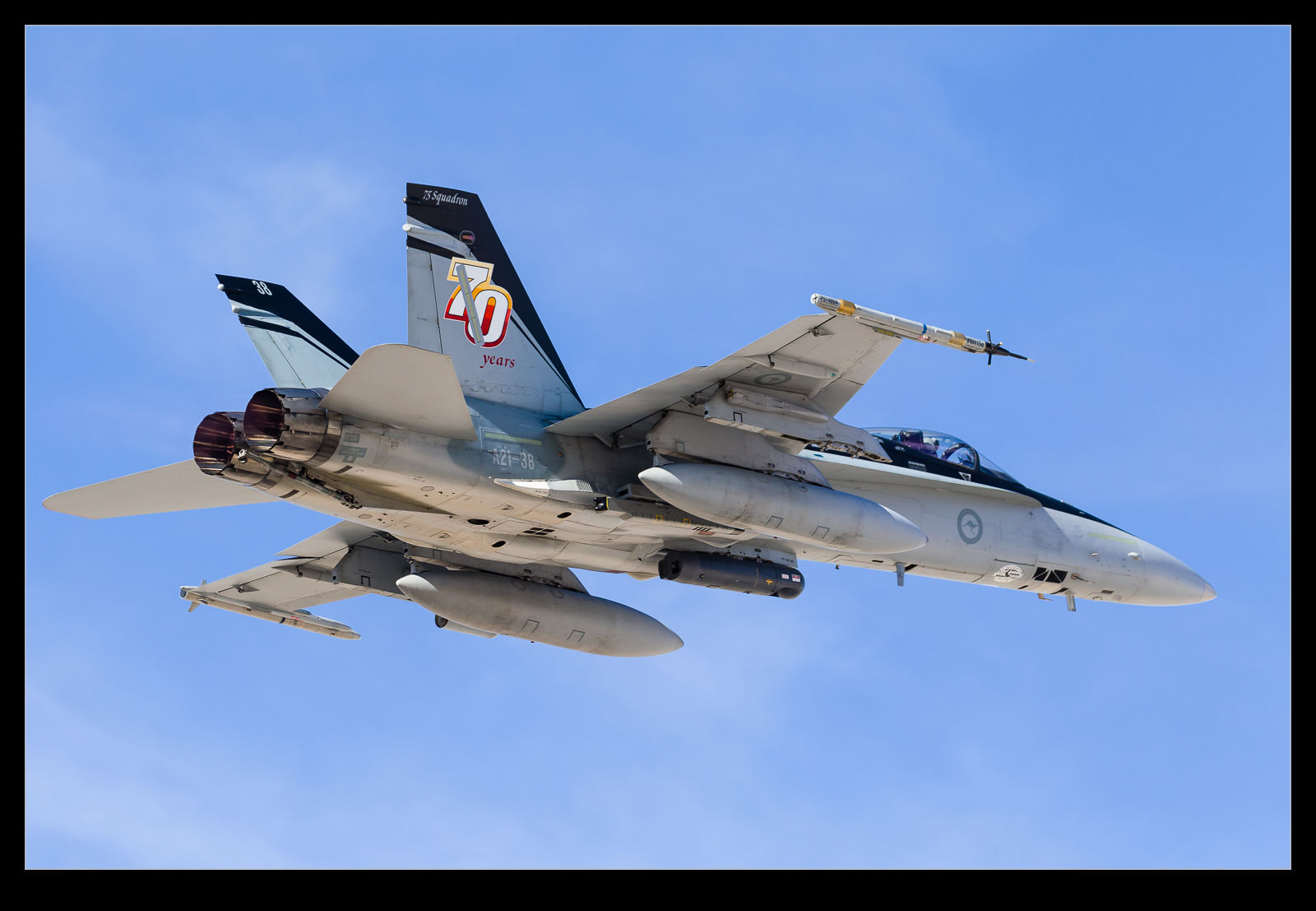 I was pleased that the Wedgetail flew on the main media day. They were alternative AWACS resources and whether this was planned or luck I don’t know. I am just glad I got to see it fly. The Hornets have been to previous Red Flags but this was the first exercise for the Super Bugs. They have been deployed on operations, though, judging by the mission markings some jets were carrying.
I was pleased that the Wedgetail flew on the main media day. They were alternative AWACS resources and whether this was planned or luck I don’t know. I am just glad I got to see it fly. The Hornets have been to previous Red Flags but this was the first exercise for the Super Bugs. They have been deployed on operations, though, judging by the mission markings some jets were carrying.
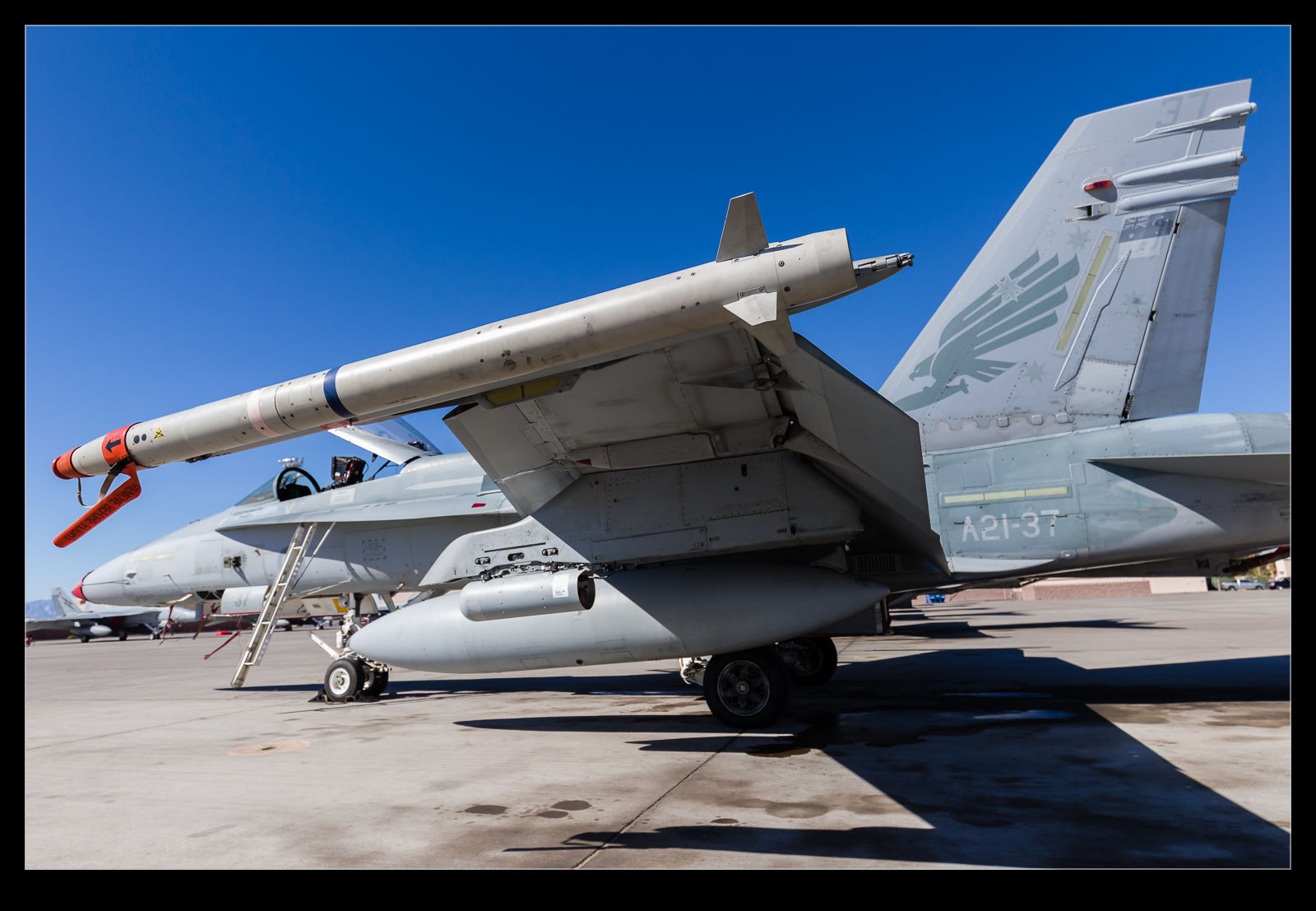 I was included in a second day on base when we got to spend some time on the Aussie ramp prior to the launch of the first mission. A team of RAAF personnel escorted us around as we got a chance to check out both generations of Hornet. One of the legacy Hornets was carrying squadron anniversary markings which looked good on it. The team was operating out of a building that they had temporarily adorned with something more personnel. If you don’t immediately get it, say the phrase out loud as a response to the question “Where are you from?”
I was included in a second day on base when we got to spend some time on the Aussie ramp prior to the launch of the first mission. A team of RAAF personnel escorted us around as we got a chance to check out both generations of Hornet. One of the legacy Hornets was carrying squadron anniversary markings which looked good on it. The team was operating out of a building that they had temporarily adorned with something more personnel. If you don’t immediately get it, say the phrase out loud as a response to the question “Where are you from?”
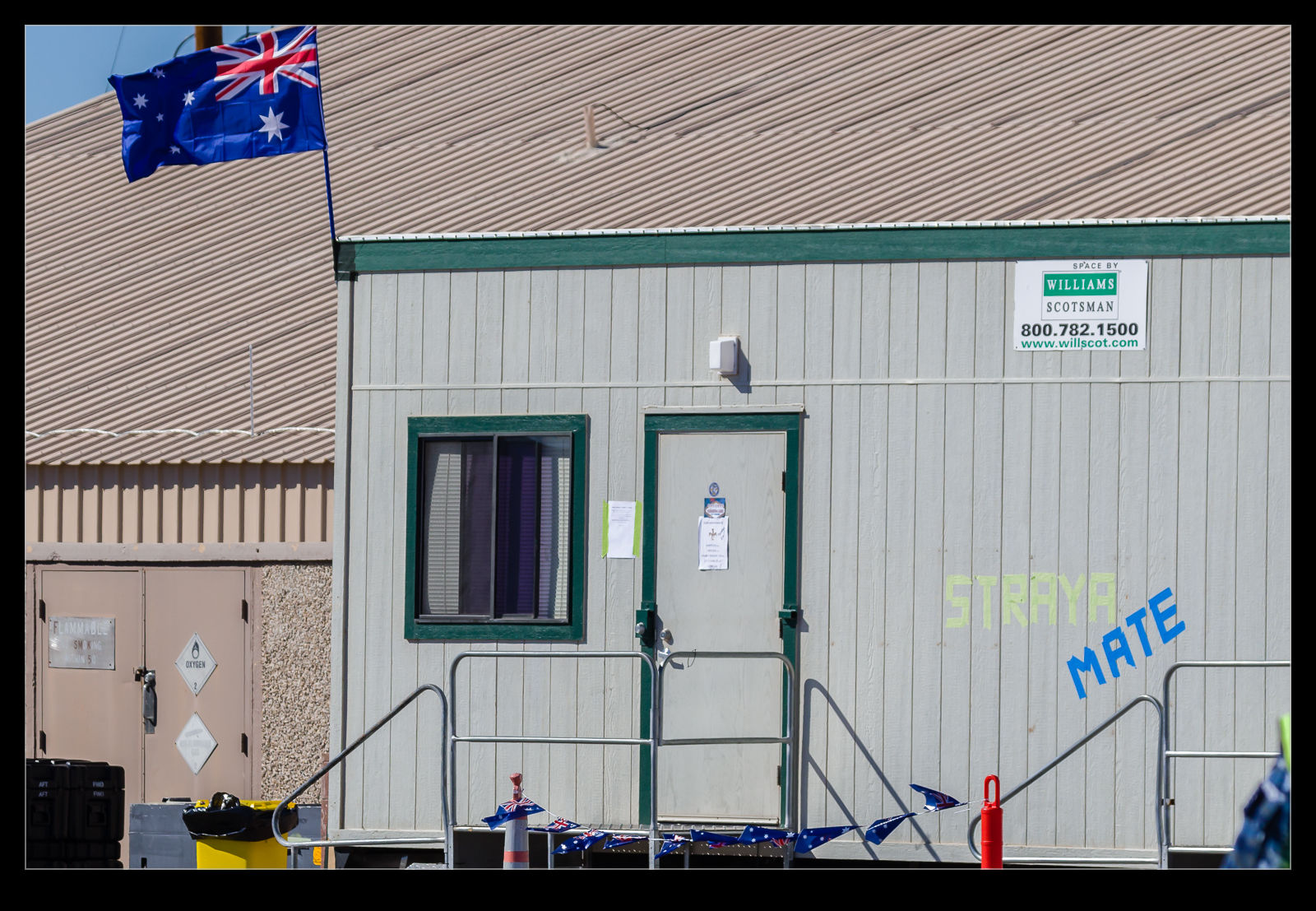 The team was also selling a bunch of squadron swag. I am not a collector of this stuff but it looked pretty cool so I was happy to part with some cash for the squadron funds. Then we retired to the EOR for the launch. Of course, that also included both types of Hornet taxiing out past us on their way to the runway. Cheers to all of the team for being so friendly and accommodating.
The team was also selling a bunch of squadron swag. I am not a collector of this stuff but it looked pretty cool so I was happy to part with some cash for the squadron funds. Then we retired to the EOR for the launch. Of course, that also included both types of Hornet taxiing out past us on their way to the runway. Cheers to all of the team for being so friendly and accommodating.
- A Royal Australian Air Force Boeing F/A-18A Hornet taxis to the runway for departure at Nellis AFB NV.
- A Royal Australian Air Force F/A-18F Super Hornet on final approach to Nellis AFB Las Vegas Nevada as part of a Red Flag mission.
- A Royal Australian Air Force Boeing F/A-18F Super Hornet cames in to land at Nellis AFB NV.
- A Royal Australian Air Force F/A-18A Hornet climbs away from Nellis AFB Las Vegas Nevada on a Red Flag Mission.
- A Royal Australian Air Force Boeing E-7 Wedgetail airborne early warning aircraft on final approach to Nellis AFB NV.
- A Royal Australian Air Force E-7 Wedgetail on final approach at Nellis AFB Las Vegas Nevada after a Red Flag mission.
RAF Sentinel
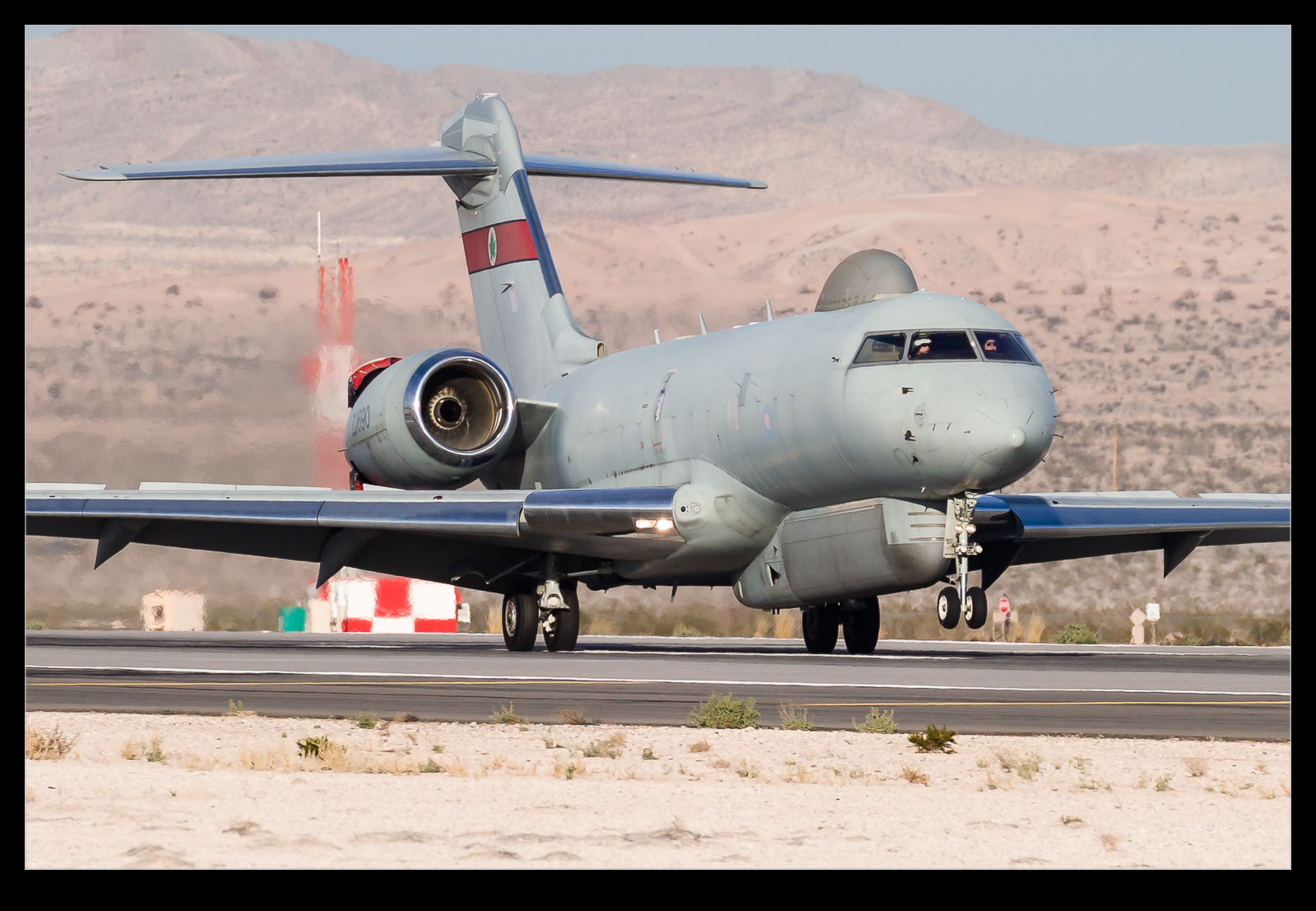 I really do appreciate an aircraft that looks elegant. One such type is the Bombardier Global Express. Built to take on the Gulfstream family, it is a great looking plane with a graceful front fuselage, cracking looking wing and even the empennage is stylishly done. Therefore, you might be forgiven for thinking that I was not impressed when Raytheon took a great looking plane and grafted on some enormous lumps and bumps to create the Sentinel.
I really do appreciate an aircraft that looks elegant. One such type is the Bombardier Global Express. Built to take on the Gulfstream family, it is a great looking plane with a graceful front fuselage, cracking looking wing and even the empennage is stylishly done. Therefore, you might be forgiven for thinking that I was not impressed when Raytheon took a great looking plane and grafted on some enormous lumps and bumps to create the Sentinel.
Built for Britain’s Royal Air Force, the Sentinel is a battlefield surveillance aircraft in the mold of the USAF JSTARS program but a generation on a bit more compact. It also makes use of a more modern airframe as its starting point. While the changes have not done anything to make the plane look pretty, I do have a soft spot for unusual aircraft configurations and large radomes and sitcom covers fit with this idea. Consequently, I rather like the Sentinel. Seeing them in action at Red Flag was a nice opportunity.
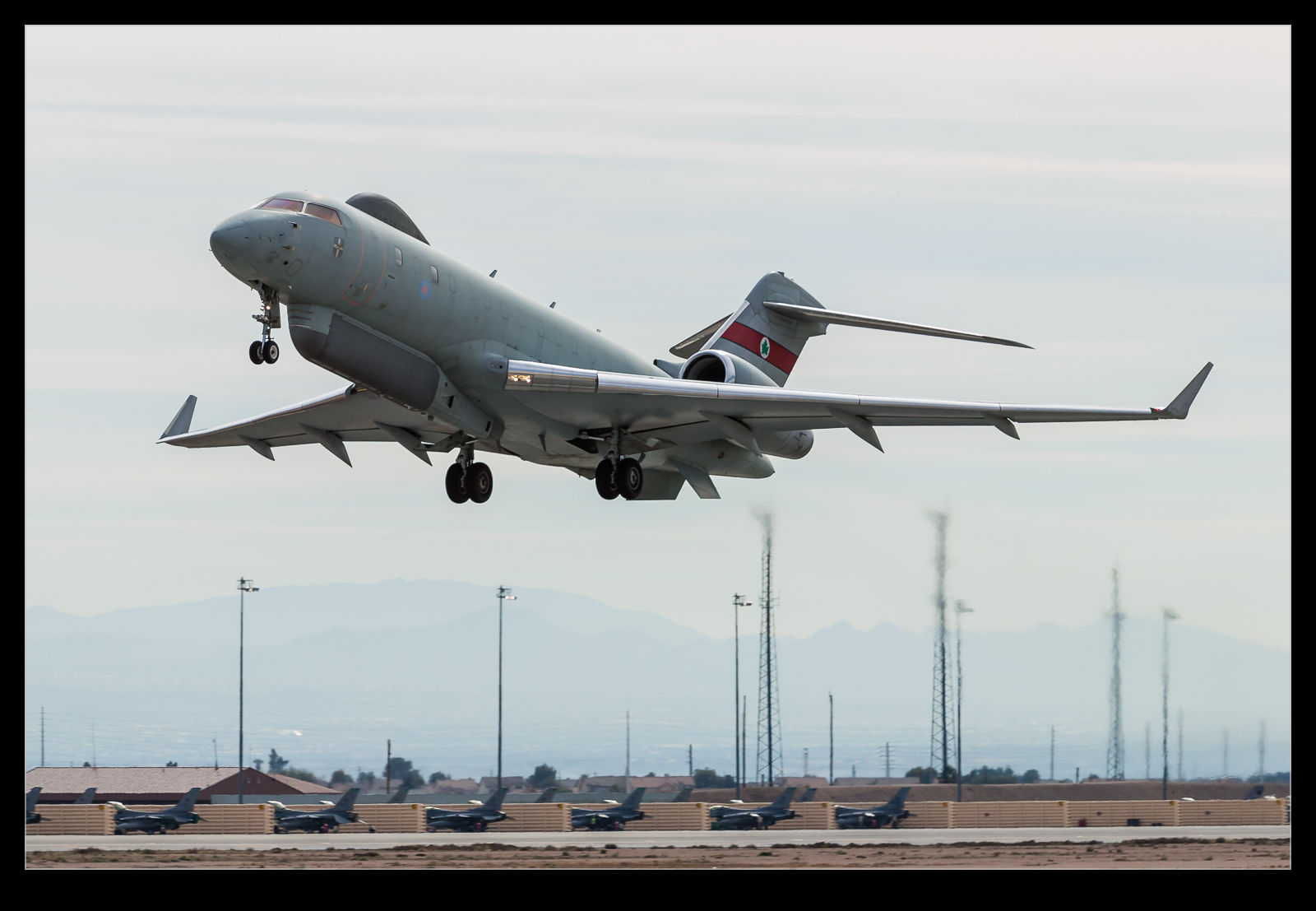 Having spent a lot of money on the Sentinel, the UK government announced that, with the reduction in involvement in Afghanistan, the Sentinels would be retired. Retirement sounds inappropriate for something so new but that was the story. Fortunately, it appears that the plan has been adjusted and they have been reprieved for now. We shall see how that develops.
Having spent a lot of money on the Sentinel, the UK government announced that, with the reduction in involvement in Afghanistan, the Sentinels would be retired. Retirement sounds inappropriate for something so new but that was the story. Fortunately, it appears that the plan has been adjusted and they have been reprieved for now. We shall see how that develops.
The aircraft are operated by 5 (AC) Squadron of the RAF. 5 Sqn was one of the early Tornado ADV squadrons when it converted to Lightnings. I liked their colors with the maple leaf on a red background. When I worked at Warton, one side project I got involved with was the repainting of a restored Lightning in 5 Sqn colors before it was put on display. Having the Sentinels showing up from 5 Sqn was nice, not least because one of the two jets had the squadron colors displayed over the usual dull grey finish. Both aircraft flew while I was there both day and night. They are an unusual sight to see so it was good to catch them at work.
